- Preparing for IELTS
- Practice tests
- Free online IELTS Writing practice tests
- Free online IELTS Academic Writing practice tests - paper

IELTS practice Academic Writing test - Task 1
How to approach academic writing task 1.
In the IELTS Academic Writing test, you will have one hour to complete both of the two set writing tasks. Keep an eye on the time it takes you to complete practice Tasks 1 and 2 to make sure you don’t go too far over, and to use as a benchmark for how long you can expect each task to take you.
In the actual test, you will move from the first to the second task without a break. However, while practising, you may wish to reflect on the outcomes of practice Task 1 using the model answer provided before moving on to practice Task 2. Or you may wish to complete them both before looking at the model answers to give you a more accurate sense of timing.
An easy reminder…
Q: How long should I spend on IELTS Writing Task 1?
A: We suggest 20 minutes – saving 40 minutes for Task 2.
Q: How many words for IELTS Writing Task 1?
A: 150 words is about the right length, but don’t be afraid to go a little over.
Q: Should I be formal or conversational in style?
A: You should write in a formal style, suited to an academic environment.
Q: What are the do’s and don’ts in IELTS Writing task 1?
A: Do pay attention to time - task 1 is worth one third of the total marks (while task 2 is worth two thirds), Don’t let nervousness stop you from trying your best.
Get more tips to help you prepare for the writing tasks
Task 1 – Take a look at the chart below and perform the task as outlined:
This graph shows the proportion of four different materials that were recycled from 1982 to 2010 in a particular country.
Summarise the information by selecting and reporting the main features, making comparisons where relevant.

What should I do next?
Once you’ve finished, you can download the model answer for Writing Task 1 and see how your work compares.
This sample offers a useful guide for how to structure your answer for IELTS writing task 1, as well as the style of writing expected. A good way to improve is to reflect on how your answer compares to the model answer – and, of course, keep practicing.
If you want to see an example of an actual answer sheet for the IELTS Academic Writing test (‘on paper’ version), you can download a sample copy below.
- IELTS practice Academic Writing test - Task 2
- Skip to primary navigation
- Skip to main content
- Skip to primary sidebar
- Skip to footer

IELTS Advantage
IELTS Preparation Courses
IELTS Writing Task 1: Everything You Need to Know
Ielts writing task 1 in 6 simple steps.
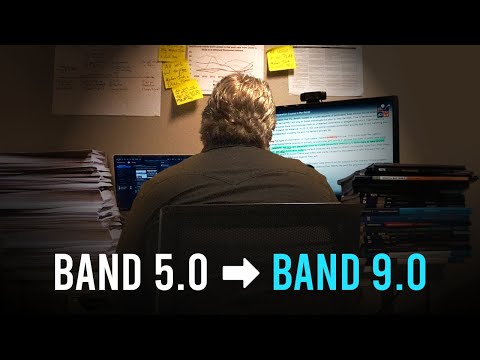
Academic Writing Task 1 Strategy
- Understand how the test is marked. Knowing the marking criteria will allow you to give the examiner exactly what they need.
- Paraphrase the question. It is best to paraphrase the question in the first paragraph. You can do this by using synonyms.
- Write the overview. To write your overview , pick 3 or 4 of the main features and write about them generally without referencing any data.
- Support the main features. In a new paragraph, support the key features with the data in the information given to you.
- Check your work. Check your report for spelling and grammar mistakes. Make sure that the data you mentioned is also accurate!

Essential Writing Task 1 Skills
- How to Write an Overview Paragraph
- How to Paraphrase
- How to Write a Complex Sentence
- How Many Words?
- Task 1 Charts Checklist
- Task 1 Tips
- The Danger of Synonyms
- 6 Common Mistakes
- Paragraphing and Editing
Writing Task 1 Full Lessons
- Writing Academic Task 1 in 5 Easy Steps
- Charts Lesson
- Maps Lesson
- Multiple Charts/Graphs
- Process Lesson

Academic Task 1 Sample Answers
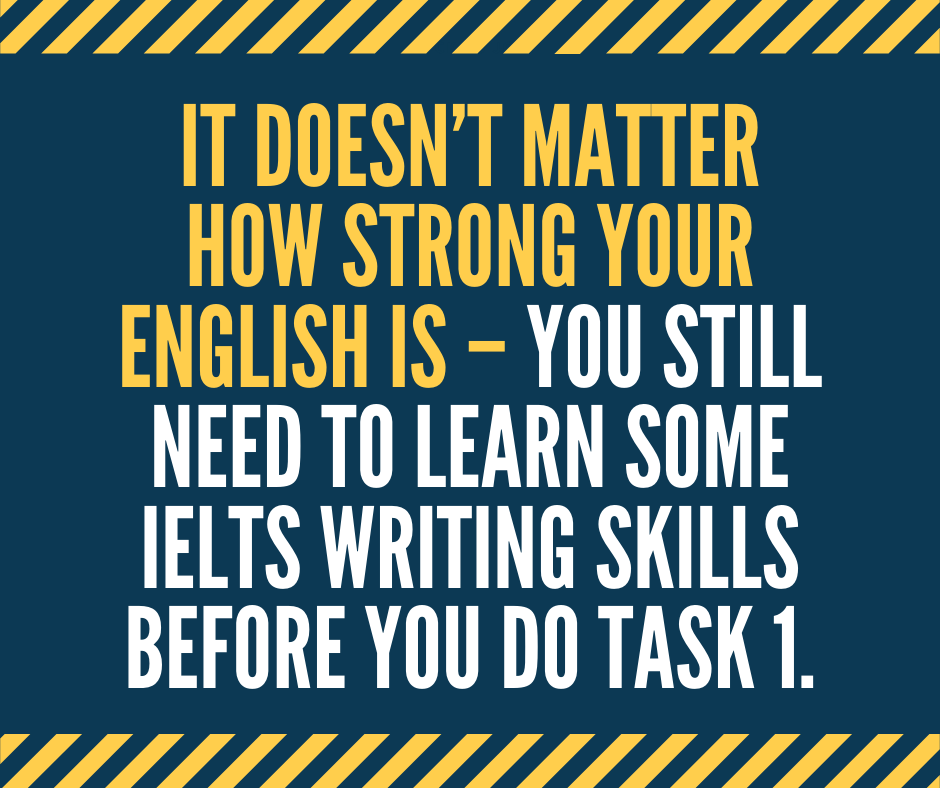
- Bar Chart Sample Essay (Cars in Asia)
- Process- Cement and Concrete Production
- Pie Chart (Italy and Yemen Populations)
- Process Question
- Bar Chart Question (UK Telephone Usage)
- Line Graph (US Consumption of Energy)
- Bar Chart Sample Answer (International Students)
General Training Writing Task 1

General Training Writing Task 1 in 5 Simple Steps
- Understand how the test is marked. Knowing the marking criteria is the best way of giving the examiner exactly what they need and nothing else.
- Decide whether the letter is formal or informal. This part is easy. If the question asks you to write to a ‘friend’, it should be an informal letter. If the question asks you to write to anyone else, it should be a formal letter. It is that simple!
- Discuss each bullet point from the question. Make sure to take a new paragraph for each bullet point. This will make your letter easy to read and understand.
- Sign off your letter. Don’t overcomplicate this part. Include a sign-off suitable to your letter’s tone and write your name beneath.
- Check your work. Make sure your letter doesn’t contain any grammar or vocabulary mistakes.
- Letter Writing Tips
- How to Write an Informal Letter
- How to Write a Formal Letter
General Training Essential Writing Task 1 Skills
- Task 1 General Training Writing Strategy
- Task 1 General Training Writing Guide
Sample Answers
- Formal and informal sample letters.
Writing Task 1 Essential Information
- People doing the Academic test will write a report on a data set, map, or process. People doing General Training will write a letter.
- You must write 150 words or more.
- You should spend around 20 minutes on this part of the test.
- Task 1 is worth 1/3 of your total mark on the Writing test.
- You will be assessed in four areas: Task Achievement (25%) Coherence and Cohesion (25%) Lexical Resource (25%) Grammatical Range and Accuracy (25%)
- The most important thing is that you can demonstrate that you can clearly communicate in English.
- The key to doing well is to know exactly what the examiners want and give it to them.
- Grammar and Vocabulary Guide

- Top 10 Grammar Mistakes
IELTS Writing Task 1 FAQs
How can i improve my writing.
You will find all the resources you need on our Writing Task 1 page. Click the link below:
Writing Task 1
If you need serious help or personalised feedback, you should check out our online course. There is a waiting list, but you can add your name here:
How can I get a Band 7, 8 or 9?
The answer to this question is different for every individual IELTS student, as it depends on a number of factors, including your work ethic, English skills and exam strategy. You'll find a guide to answering this question in this article
If you need serious help with improving your IELTS scores, you should check out our online writing course. There is a waiting list, but you can add your name by clicking the link below:
Can you correct my writing?
Please click the link below and it will give you all the information you need about our writing correction service:
Writing Correction Service
Do you have any sample answers?
Yes, you will find them at the link below:
Task 1 Sample Answers
Will using 'high level' or 'academic' words help me improve my score?
Probably not.
Read my recent article about IELTS vocabulary here:
5 Things You Need to Know about IELTS Vocabulary
How many paragraphs should I write?
Introduction
You can put the overview at the end if you'd like.
Can I use idioms?
No, you should typically avoid using idioms in Writing Task 1.
The only time this is acceptable is if you are taking the General Training test and must write an informal letter.
Should I write a conclusion for Task 1 Academic?
No. A conclusion is a summary of YOUR ideas and your opinion. Task 1 is simply reporting what you see, so there shouldn't be any of your ideas or your opinion.
Instead of a conclusion, you should write an overview.
The reason lots of people get confused about this is that some teachers, books and even one British Council website call the overview a 'conclusion'. It's not a conclusion, it's an overview.
Finally, it does not matter where you put the overview paragraph. We teach our students to put it after the introduction, but it is also fine to have it as your final paragraph.
How many words should I write?
You must write at least 150 words in Writing Task 1 (yes, the examiners will count them!)
I would suggest that you aim to write around 160-170 words for Task 1. Aiming for 20-30 words more than the required amount makes you more likely to reach the word limit without setting an unrealistic goal.
Will I lose marks if I don't write enough words?
Yes. If you don't write the required number of words, you will lose marks in 'Task Achievement' for not answering the question fully. Read more here .
Can I use contractions?
No, should not use contractions when you are writing an academic essay or formal letter. However, it is fine to use contractions in an informal letter.
When should I write formally?
There are a few signposts that indicate when you should write formally or informally. Watch our video lesson to find out what they are:
IELTS Writing Task 1 General Training: Formal or Informal Letters?
IELTS Academic Writing Task 1 – Sample Answers
Here are a number of writing task 1 sample essays for you to look at. Take a look through the questions and sample answers and compare them to your own work. Are they similar? Do you find them easy to understand? Do they answer the question? Can you see how the information has been structured?
It is important for you to look at sample essays when you are studying to see if your work is on the way to becoming a band score 7 or higher.
Read through the essay feedback and see why the essays have achieved a band score 9 . The band 9 criteria are also at the end of this post.
Sample Essay 1 – Pie Charts
The pie charts show the ratio of goods shipped from Great Britain from 2010 to 2015. The products are measured by percentage.
Overall, over the five-year period, the most exported goods were machinery and vehicles. These two types of goods were predominantly wanted out of all of the categories. The least amounts of goods exported were plastics and organic chemicals. Minimal changes occurred over the selected time period.
On the one hand, machinery exports have a small increase as the amounts moved are 29% and 30% respectively. The percentage of vehicles shipped only rose slightly by 1% from 2010 (28%) to 2015 (29%). The machinery and vehicles export pattern remained steady throughout the five years.
On the other hand, the diagrams illustrate an increasing rise in the production of plastics at over 4% since 2010. Furthermore, the most relevant feature is the increase in the export of organic chemicals from 2010 (7%) to 2015 (10%). There is a huge difference in the production of pharmaceuticals, due to the fact that it experienced a decrease from 2010 (27%) to 2015 (18%).
(Word Count = 180 / Band Score 9)

- Task Achievement – The answer provides a paraphrased question, to begin with, followed by an overview that gives the reader key information. The information selected is relevant.
- Coherence and Cohesion – The answer has been divided into clear logical paragraphs.
- Lexical Resource – There is evidence of paraphrasing, synonyms and some less common words.
- Grammatical Range and Accuracy – The answer has no grammatical errors. The sentences are mainly made up of multiple clauses and have a variety of structures.
TIP >> Remember to identify two or three main features and write about those. You don’t need to write about everything you see in order to gain a high band score.
Sample Essay 2 – Line Graph Showing Future Trends
The line graph presented depicts the loan status of the Royal Bank of Scotland between the years 2012 to 2022. It is measured in millions of pounds sterling.
Overall, it can be seen that while student loans and mortgages are predicted to increase simultaneously over the period, auto loans and personal loans have highs and lows, therefore remaining much lower in comparison.
Firstly, it is clear that student loans and mortgages are following a very similar pattern over the years. Student loans stood at just under 1.500 million in 2012, noticeably, being the highest of the four groups. Though they remained constant up to 2013, they are expected to climb steadily to approximately 2.5 billion in 2022. Like the student loans, mortgages are predicted to follow a similar pattern and increase.
Secondly, auto loans are expected to show abnormalities of both highs and lows during the years. Although having initially grown, they will drop to 700 million in 2016, before reaching the peak of about 1500 million in 2020. Auto loans will end close to the amount where they began.
Finally, personal loans were staged at the lowest level of the four groups, at under 500 million in 2012. Despite climbing up and overtaking auto loans briefly in 2016 to about 800 million, this level will continue decreasing until 2022 to 400 million.
(Word Count = 223 / Band Score 9)
- Task Achievement – The answer provides a paraphrased question, to begin with, followed by an overview that gives the reader key information. The final sentence has a future prediction.
- Coherence and Cohesion – The answer has been divided into clear logical paragraphs. The overview explains the trends generally then the specific information is written about in the main body paragraphs.
- Lexical Resource – There is evidence of paraphrasing, synonyms and some less common words. Specific vocabulary used to describe change over time has been used.
- Grammatical Range and Accuracy – The answer has no grammatical errors. The sentences have a variety of structures.
TIP >> Remember to end the essay with a prediction for the future , after looking at the present.
Sample Essay 3 – Process
The illustration shows the whole process of how a hydroelectric dam manufactures electricity from water.
Overall the main element of the procedure is the flow of water, making a reservoir of water, this is the first step until the last step where the power is produced and distributed. There are 5 main steps in this process.
To begin, a body of water is stored in a large water reservoir holding the water until it goes into the intake. The dam will then control the flow of water to the intake. After that, water will flow to a cylindrical passage called a penstock, making it flow with a strong pressure until it reaches the turbine. Next, the current of the flowing water from the river passing through the penstock will maintain the turbine’s rotation.
Subsequently, the rotation of the turbine would produce energy that will pass through a generator until electricity is produced. The generator is inside of the powerhouse, where long distance power lines are connected. Finally, from the generator, electricity is then transmitted to long distance power lines.
(Word Count = 178 / Band Score 9)
- Task Achievement – The answer provides relevant information, describing the process through every stage. The overview gives clear information, leading into the main body paragraphs.
- Coherence and Cohesion – The answer has been divided into clear logical paragraphs, with clear cohesion between them with the addition of time connectors (after that, next, subsequently, finally).
- Lexical Resource – There is evidence of paraphrasing, synonyms and some less common words.
- Grammatical Range and Accuracy – The answer has no grammatical errors. The sentences are mainly made up of multiple clauses and have a variety of structures. There are no spelling mistakes and punctuation is correct.
TIP >> Write a good overview , with how many stages the process has, starting with….. and ending with……then go into the main detail of describing the process into the main body paragraphs.
TIP >> Describe the process and lead the reader through it by using time connectors.
Sample Essay 4 – Line Graph
The line graph illustrates the climate conditions in Athens, Barcelona, and Sydney over the period of one year.
Overall, it can be seen that generally, the cities of Athens and Barcelona have a similar temperature movement in comparison with Sydney. Both Athens and Barcelona’s temperatures peak during the summer months of June, July and August, while Sydney has lower temperatures during those three months. In contrast, Sydney’s highest temperatures are when Athens and Barcelona have their lowest.
To begin with, Athens has approximately 8 degrees of temperature in January with a gradual increase to 25 degrees in June. However, this trend slowly declined each month reaching close to 8 degrees by December. Similarly, Barcelona had a similar trend but started with just a little below 7 degrees in January. Nonetheless, after the succeeding months, there had been a steep incline to the temperature that peaked at around 28 degrees in August. But, a sudden drop to nearly 5 degrees per month was experienced for the remaining months until December with exact 6 degrees.
In contrast to Athens and Barcelona, Sydney’s temperature was just a little over 27 degrees in January but slowly decreased in the following months, reaching the lowest point at 14 degrees in July. Finally, this average monthly temperature incrementally increased each month, ending with the same temperature of 25 degrees in December.
(Word Count = 225 / Band Score 9)
- Task Achievement – The answer provides a paraphrased question, to begin with, followed by an overview that gives the reader key information.
- Coherence and Cohesion – The answer has been divided into clear logical paragraphs. The overview explains the trends generally, then the specific information is written about in the main body paragraphs.
TIP >> Remember to compare and contrast information, using cohesive devices , such as overall, to begin with, similarly and finally.
Sample Essay 5 – Table
The table illustrates the percentage of people who decided to shop in a humane way from 2012 to 2014.
Overall, it is evident that the free range/organic and fairtrade experienced declines in numbers of shoppers, whereas the pre-loved clothes became the most wanted items during the same period.
To begin, the proportion of people buying ethical clothing fell from just over half to only 20% or one fifth from 2012 to 2014. Similarly, the relative number of people buying Fairtrade items — just under one quarter — dropped by half in the same period. As for the free range and organic products, the relatively small percentage of people buying this type of product in 2012 (12%) also fell, although not significantly.
However, while the other three types of ethical shopping declined in importance, the opposite was true in the case of pre-loved clothes. In fact, while only a small minority of 12% were interested in purchasing these in 2012, this figure increased to well over half of all shoppers during the following two years reaching 58% in 2014.
- Task Achievement – The answer provides a paraphrased question, to begin with, followed by an overview that gives the reader key information that is supported by data from the table.
TIP >> Remember to highlight any trends that stand out , for example in this table, the number of people buying pre-loved clothes in 2014.
Writing Task 1 Band Score 9 Criteria >>
Ielts writing task 2 question types.
Agree/Disagree Essays ADVANTAGE / DISADVANTAGE ESSAY CAUSE AND EFFECT ESSAY IELTS Problem/Solution Essay IELTS Discussion Essay POSITIVE OR NEGATIVE ESSAY Direct Question Essay IELTS Writing Task 2 Student Essay
We hope you found this post useful in helping you to study for the IELTS Test . If you have any questions please let us know in the comments below or on the Facebook page.
The best way to keep up to date with posts like this is to like us on Facebook , then follow us on Instagram and Pinterest .
If you need help preparing for the IELTS Test, join the IELTS Achieve Academy and see how we can assist you to achieve your desired band score. We offer an essay correction service, mock exams and online courses.
Related Posts

IELTS Discussion Essay Sample 5 – Environment
IELTS Writing Task 2 discussion essay example that is a band score 8. The question…
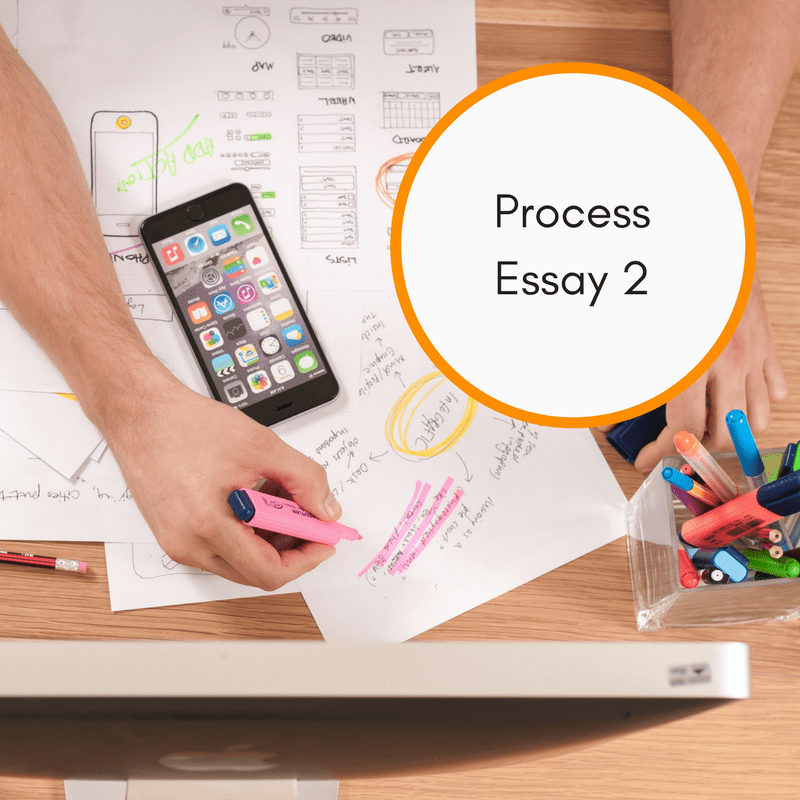
IELTS Writing Task 1 – Process Example Essay 2
IELTS Writing Task 1 Academic process essay example that is a band score 8. The…
Leave a Comment Cancel Reply
Your email address will not be published. Required fields are marked *
Save my name, email, and website in this browser for the next time I comment.
IELTS Preparation with Liz: Free IELTS Tips and Lessons, 2024
- Test Information FAQ
- Band Scores
- IELTS Candidate Success Tips
- Computer IELTS: Pros & Cons
- How to Prepare
- Useful Links & Resources
- Recommended Books
- Writing Task 1
- Writing Task 2
- Speaking Part 1 Topics
- Speaking Part 2 Topics
- Speaking Part 3 Topics
- 100 Essay Questions
- On The Day Tips
- Top Results
- Advanced IELTS
IELTS Writing Task 1: Essential Preparation Tips
Below are the essential preparation tips to learn how to prepare for your IELTS writing task 1 test. These top 12 tips are for the IELTS academic writing paper.
1. Understanding Task 1
- write an academic report on a chart of graph (see below for all types of task 1)
- write over 150 words (the examiner will count your words and there will be a penalty for being under the word count)
- write your report in 20 mins (don’t take more time because task 2 is worth double the marks)
2. Practice Tests
Get the Cambridge IELTS Practice test book s. There are 9 books which have been published by IELTS. Each books contains 4 full IELTS tests which are authentic (real) past exam papers.
3. Task 1 Band Scores and Marking Criteria
Understand the band scores for each criterion in writing task 1. The IELTS examiner will mark you on:
- Task Achievement (25%)
- Coherence and Cohesion (25%)
- Vocabulary (25%)
- Grammatical Range and Accuracy (25%)
Get to know the requirements for each criterion for the band score you are aiming for. Here’s a link to the IELTS writing task 1 public band score descriptors which are published by IELTS. The examiner will give you a band score for each individual criterion above and then your final score for writing task 1 is the average of the 4.
4. Types of Task 1
Learn the 6 main types of charts that can be given in writing task 1 (maps, diagrams, bar charts, tables, line graphs and pie charts). You should practice writing reports for all types of task 1 by using sample IELTS charts . It is also possible to get a combination of two types, for example a bar chart with a pie chart.
5. Introduction Paragraph
Practice writing the introduction statement. Here are two examples, which one do you think it best?
- Here we can see that the graph represented information regarding the number of sales of two companies in two years
- The chart illustrates the number of sales of two companies (Marks Ltd and Bumper Store) in 2000 and 2010.
The introduction is usually very quick to write and quite formulaic (standard) in content. Here’s a link to see how to write an introduction for a bar chart .
6. Overviews for Writing Task 1
Practice identifying key features for all kinds of charts. The key features make up the content of the overview which is the most essential paragraph in your task 1 report. The key features for most charts are the highest and lowest categories as well as the most significant differences between categories. However, for diagrams the key stages can be harder to identify so here a link to a sample introduction and overview for an IELTS diagram. Many students get confused whether to have a conclusion or an overview – make sure you get it right.
7. Vocabulary
Get a list of useful vocabulary for each type of writing task. This is particularly important for line graphs, maps and pie charts. The line graph is the type of writing task 1 which has the biggest range of possible vocabulary that can be used. Here’s a link to vocabulary for line graphs .
To get a good score in writing task 1, it is important to use a range of words which means you need to paraphrase when possible. However, as mistakes can cause you to lose points, it is important not to take chances with your vocabulary. Spelling is also checked so make sure you don’t make mistakes with your spelling.
To get a good score, you will also need to work on complex sentence structures. For students aiming for band score 6 and above, this is essential. Luckily sentence structures for task 1 can be learnt and then adapted to fit each individual task (to some extent). Here’s a link to the 4 main sentence structures for a line graph . Along with grammar is accuracy. The more mistakes you make the lower your score will be so getting rid of common errors is important. Here is a link to spotting grammar mistakes for a pie chart. If you have frequent errors, you may get band score 5 for grammar.
9. Structure for Writing Task 1
You need to make sure you structure your report correctly as the examiner will pay attention to the organisation of information and paragraphing. Here’s a link to the structure for IELTS writing task 1 report. Make sure you follow this as it is easy to get a good score for organisation. Structure and linking devices are part of the criterion of Coherence and Cohesion which makes up 25% of your marks.
10. Linking Devices
Linking is also very important. You will need to show the examiner a range of linking devices that connect information together and compare information in a coherent way. Again, linking is very easy to learn so make sure you pay attention to this. Different charts use different linkers so make sure you review each type of task to see the best linking devices to use.
11. Model Answers for IELTS Writing Task 1
Follow safe models. There are a lot of sample answers for you to follow on the internet, but following a safe model which fulfills the requirement set by IELTS is essential. Here’s a link to a complete lesson on how to write a pie chart report paragraph by paragraph.
12. Practice using the Answer Sheet
Before your test, make sure you practice writing on the official IELTS answer sheet for writing task 1. Watch this video lesson to learn why you should practice with the answer sheet and how to fill it in properly. Here is a link to download the answer sheet .
Recommended
- How to describe a bar chart : Video Tutorial
- Line Graph Model Answer Band 9
Hi Liz, The information provided in your blog was very useful for my success at the exam. Your valuable time committed to provide us information is highly appreciated. I salute for your service. Thanks lot. from Sri Lanka
Glad to hear you did well 🙂
You are really a nice teacher and i did my best through your videos. Free of cost ahahahahahhahah
Hello there Liz how’s your condition ? hope you are doing well, Since You have mentioned that there are 9 IELTS Cambridge practice books, but the last I checked, there are 17 volumes, which ones do you suggest to start for band score 8 for Ielts general training, as an upper intermediate English speaker? I appreciate your support and tysm for this amazing website
Each year IELTS publish a new book. Book 17 is the latest. However, previous books are still fully valid as the test hasn’t changed except in very minor ways, such as being on computer or the listening test no longer having an example at the start of the audio.
Hi Lizzy . Please I can’t t see your recent videos.
I stopped making videos in 2015 and will start again once my health improves. I do, however, continue updating this website with new tips and lessons.
Hey Liz, Today is my first day of IELTS preparation and I found this amazing creation by you. Its already making things easier. Thank you so much!!
I’m glad my lessons are helping you 🙂
Hi Liz. Thank you for the free lessons and tips. I will like to know if the overview for task 1 Writing can be separated from the intro soon a separate paragraph.
Yes, definitely. I usually write my overview as a separate paragraph as it’s the most important paragraph in task 1.
Hi, Elizabeth. It’s been a pleasure for me to practice woth your resources. Thanks for building such a prolific platform for IELTS aspirants
You’re welcome 🙂
Thanks a lot for you great explanations! Just wanted to let you know the link to “conclusion or overview” under point 6 is broken. Best,
Thanks David. I just fixed it. Happy 2021 !
Thank you so much Ma. Your site was very useful to my preparation. My results just came in and I scored 8.0. I’ll gladly recommend this site for others. God bless you!!
Wonderful news!! Very well done 🙂
I cannot thank you enough for the tip to write an overview after the introduction paragraph. I have just received my test results for IELTS Academic and they are 8.5 overall and 7.5 for Writing. I had limited time to prepare for the test and read the tip while in a cab on the way to the test venue. During the Writing part I did the Task 2 first and it took me all of the 41 minutes (and 440 words), with only 19 minutes remaining for the Task 1. Luckily, it was a simple chart and I wrote the introduction and overview first, then wrote two body paragraphs with barely a minute to check for typos and the time was up. I ended up writing 220 words and would have written more if not for the time limit. However, since I made sure I wrote the overview first, I was able to relax and found it so much easier to concentrate on the details of the chart. Thank you for the brilliant idea! None of the other teachers online came up with it.
Great results 🙂 Writing the overview after the introduction is logical. Task 1 is a report and the overview contains the main details of the report so having presenting that early helps both the reader and the writer. Also, as you said, it ensures you don’t miss it if time is limited. Well done to you 🙂
I am glad to have come across this material for the preparation of IELTS exam, Just wanted to know about the general mistakes I (a candidate) might have been doing while going for the Writing portion of the Test. Just to give you a brief, I have appeared for IELTS about 3 times now and have never touched band 7.0 in each attempt (To be precise, I got 6.5 in all attempts in writing particularly), However rest of the sections speak a different story (Getting at least 8.0 in each section respectively). Can you please advise as to what I might be doing wrong in Writing section in particular. I try to increase my Vocabulary learning new words each day and implement those words in my sentence formations as well.
Be careful learning new words and using them in your essay. If you use them incorrectly or inappropriately, your score will go down. It takes time to learn words properly so that you can use them without errors. Avoiding errors MUST be your main goal in IELTS Writing. Also review ALL my free lessons and tips: https://ieltsliz.com/ielts-writing-task-2/ . Then consider my Advanced Lessons which will give you the right techniques for a high score: https://elizabethferguson.podia.com/
Hi Liz, Your site is very helpful! Thank you! I see you have recommended the Cambridge IELTs book. They have now released no. 10. Would this be a good resource for the Academic test? I am a native English speaker but not achieving the writing score I need. Your help would be greatly appreciated! Kind regards, Jade
Book 14 is the most recent and book 15 is coming out this summer. They are the only authentic past papers you can buy. Yes, you should be using them. How many you wish to get is your choice and will depend on how much prep you wish to do. These books contain tests, not training or advice or understanding. They won’t help you learn how to tackle IELTS writing and they won’t help you understand the band score requirements. Try my free lessons: https://ieltsliz.com/ielts-writing-task-2/ and my Advanced Lessons: https://elizabethferguson.podia.com/
Sorry The question about private lessons and marking writings was meant to be asked to you, Liz. I need the answer as soon as possible please.
Unfortunately, because I work alone, I do not have time to offer private lessons or marking. However, my advanced writing task 2 lessons are very detailed and will answer most of your concerns: https://elizabethferguson.podia.com/
Someone who corrects my essay tells me that don’t use brackets if you want to have high scores. So, i’m quite confused about it because you said it is perfectly normal to use brackets in writing task 1 in the video.
It is completely fine to use brackets for task 1. However, don’t overuse them. Always show flexibility and a good range of sentence structures by presenting data in different ways.
Thanks a lot Liz. This website is really helpful to prepare IELTS.
i am unable to download the answer sheet of IELTS writing test. The link already present is broken. Can you please attach the correct link here.
Thanks for letting me know. I’ve just put up a new link.
No words enough to show my gratitude! May God bless you.
Thanks Liz.
I absolutely loved your site and way of guiding to obtain a good IELTS result.
My writting task definitely felt much better with your tips and guidance.
Today I took the test, I hope the results are positive.
Keep up the good work!
Fingers crossed for you 🙂
What is your result?
Morning Liz, Really appreciate all your efforts! Is there any Videos for “Writing- Letter (General Testing). I see lot of sample letter questions. But there are no sample letters to actually read through the whole letter and grasp the idea or I may be overlooking 🙂 Please advise- Harry
There is a link above to model letters which are full letters that you can read and learn from for IELTS.
Could you please let me know if for task1 in Ielts Academic we may receive to write a letter or that is the case only for Ielts General ?
See this page: https://ieltsliz.com/ielts-writing-task-1-lessons-and-tips/
Thanks for all your great efforts! I am wondering if it is fine to have only two sentences in my body paragraphs. Though it can be seen in examples you have provided, some other teachers say it should be at least three sentences. Which one is correct?
There is no such rule in IELTS. For writing task 2, all main points should be fully extended which means that the body paragraphs are mostly of equal length. However, writing task 1 is not an essay, it is a report. Paragraphs are not balanced in length. It is even possible to have a paragraph of one sentence. It’s fine for teachers to advise you, but they should point out that it is advice and not a rule.
Hi, I`m a content maker in iran and we work on teaching EFL. Your content is so helpful and comprehensive. i appreciate that and wish you best
Hi.. Thank you for the information. I would like to ask you a question in writing test. Is it ok if we write the reason why is the percentage different from one year to another year? Thank you
If the reason is stated in the chart, you can write it. You can only provide information that is visible in the chart – you can’t add opinions.
Thank you very much for your everything on IELTS. I Learned a lot.
I realized that now exam patterned changed little bit as Writing Task 01 , they normally give two different charts (Bar Chart & Table or Line graph with Pie Chart) .
Hope you will add some models for these kind of things.
Rgds Lalith
The patterns have not changed. They gave multiple tasks and single tasks in the past, and they do the same now. You can find model answers for all kinds on this page: https://ieltsliz.com/ielts-writing-task-1-lessons-and-tips/
i love you mam thank you soo much
Hy Liz, I just want to tell you that you are doing an amazing job, by helping alot of people understand the mechanics of IELTS, and that too for free.You are an amazing human being, may the blessings of Allah be upon you.
I followed you and IELTS Cambridge books religiously from the day i started preparation, yesterday i got my result and i got an overall 8.0 with 9.0 in reading, 8.5 in listening, 7.0 in speaking and 7.o in writing in contrast to my previous result of 7.o overall.
Thanks a lot liz and keep doing the wonderful job you are doing.
Brilliant !! Such a great improvement from band 7 to 8 !! Very well done to you 🙂 Thanks for letting me know 🙂
Hello Liz, I have some challenges in my writings. I am weary of task 2 essay writing. Pls advice me. Thanks
Get my advanced lessons – you will quickly learn how to tackle them properly: https://elizabethferguson.podia.com/
Hi liz, Can overview contain numbers, percentages or years? I have my exam very soon. Please respond at your earliest.
Yes, it is possible. There is no fixed rule. The majority of the time, the overview will contain only description. But there are cases (such as totals in a table) when the overview might contain numbers.
What if i write task 1 on task 2 sheet and task 2 on task 1 sheet.
If you do that, you will need to change the heading on the paper so that the examiner knows clearly and easily which paper is which.
Hi liz, i noticed you skipped task 1 for general training. Please how does one fill this void
On this page: https://ieltsliz.com/ielts-writing-task-1-lessons-and-tips/ , you will find essential tips for GT letter writing and also model letters.
I want to improve my speaking
See this page: https://ieltsliz.com/ielts-speaking-free-lessons-essential-tips/
Could you please upload video with tips for writing task 1 in GT . I am going to take GT in September 9.
I won’t be making more videos until next year.
Can we write hammering the last nail in task 2 of ielts wrtting in place of to conclude🤔
Don’t use informal language in an IELTS essay.
Hi liz can i ask what is the difference between campbridge textbook ielts 9 and 10? What book should i used?? Im a nurse im planning to get ielts next year.
Each book contains 4 real IELTS test published by IELTS. The books are published in order of age: book 12 is the most recent. You can use all books to help you prepare, but books 9 – 12 are the best.
From where I get written samples for writing task so I can check the pattern and follow it in my practice?
See the main pages of this website. Here is the main page for writing task 1: https://ieltsliz.com/ielts-writing-task-1-lessons-and-tips/
Hello Liz, I really appreciate your effort for posting such a useful videos. can you upload some videos of general writting task 1.
I won’t be making more videos until later this year (if I’m lucky). But I will put GT videos on my list 🙂
Hi Liz, Your website is very essential for IELTS preparation. Can you please upload a video about writing letters for general training writing test 1. Thanks and best regards.
I hope to make more videos at the end of this year.
Thank you miss. Elizabeth Oh! I could find a mistake for you, I am enthusiastic to go to the exam now 😀 * second introduction statement is better
Hi Liz, First of all I’d like to thank you for your efforts and hard working to help us improve. I have a question about academic writing task 1. what are the maximum words that we should write? Is it ok if I write 216 words in this task? Best regards, 😀
If your writing task 1 report contains too many small details, you will get a lower mark. 25% of your marks for task 1 is your ability to select information and highlight key features. Of course, if the chart gives few details, then you might present all but if there is plenty of information to present then you must be selective. So, writing over 200 words is not showing the skill of selecting.
Do you have an overview of when to write a conclusion section for writing part 1? Thank you in advance!
Kind regards
See this page: https://ieltsliz.com/ielts-tips-conclusion-or-overview-for-writing-task-1/
i wann practise ielts writing part .
https://ieltsliz.com/ielts-writing-task-2/
Hi Liz, I am planning to retake IELTS exam because I was unable to get a score of 8 and above for my writing. I need someone to critique my essays. Can you help me on this? Please contact me at: [email protected]
See this page: https://ieltsliz.com/ielts-essay-correction/
Mam… First of all Thanku so much for this website this helping us a lot for preparation… I wanna knw that what is the difference between the Cambridge ilets 9 and 11 which book is to be purchased
Book 11 is the most recent. So, go for that one.
my writing band score is not increasing.why
Go to the main writing pages, and then read about the band scores. Find your weaknesses. Alternatively see my advanced lessons: http://subscriptions.viddler.com/IELTSLizStore
hii Liz…I really appreciate your efforts for creating such a wonderful platform to score in IELTS.Your videos are helping me a lot.Thank you so much..:)
I have a question on writing task 1 . Is it fine if I write upto 190 words?
I look forward to hearing you soon.. Thanks.. Best, Pramit
There is no upper limit. Just make sure you are being selective with the information and not including irrelevant information.
Thank you so much for the response. Best, Pramit
Hi Liz, Thank you very much for helping us. I have a query about word counting. Number of articles are considered in 150 words? I look forward to hearing from you Liz. Best Regards, Manobendro Sarker
All words – big and small are counted.
do we have time for rewriting?
You have a total of 1 hour for two tasks. Time is very limited.
HI MRS Liz i have one question , when we use amount and number n how ? pls clear it for me as soon as u can because my exam next three days
should we write a conclusion or not
You will find a whole page about conclusions and overviews on this page: https://ieltsliz.com/ielts-writing-task-1-lessons-and-tips/
hi liz, can we write figures in overview paragraph?
If they are totals, yes.
from where to i could start ilets practice….?
See the video on my home page: https://ieltsliz.com/
jass…. is there any difference in idp and bc marking test
No. The marking criteria are exactly the same and the examiners are trained in the same way. These are not separate companies when it comes to IELTS, they are both co-owners of IELTS.
Hi liz!! Can I use present contin. in WT 1? , Thank you for your data!
https://ieltsliz.com/liz-notice-2015-2016/
mother u explained well
hi mam. when u will be back ?
Hi, In writing task-1, do we also have to analyse the figures? Like for example, if the question is about people listening radio and watching TV, then do we also have to write like..people probably don’t watch TV in morning because they are working in office. Or we just have to stick to explaining the graph backing the statement by data? (Interpretation and analysis both or just the interpretation?)
You never give an opinion or try to give reasons for it. You report what you see. This is report, not an essay. All the best Liz
Do you have an idea in terms of which test is easier to take on the following: IELTS Academic,PTE Academic,TOEFL and CAE?
Sorry, I only work with IELTS and am not very familiar with other testing systems. Liz
Thanks for responding,in terms of the academic,how different is it from the GT? I know listening and speaking its the same exam. The difference is on reading and writing where in writing there is the issue of graphs being part of the curriculum.
I have a date on the 19th of November and i want to ask for assistance in terms of advice as to which areas i can make sure by the time i get to the exam will have mastered. regards Jasiel
The GT test is slightly easier for writing and reading. See these pages: https://ieltsliz.com/ielts-gt-academic-writing-differences/ and also https://ieltsliz.com/ielts-general-training-reading-information/ All the best Liz
Kindly assist me,I took a GT exam for immigration to Australia and did not do well in listening because i want 8 band across all modules.
I have a date for academic but wanted to find out if the band will be reduced because i am taking Academic instead of GT, and is it difficult as people say because i could have taken CAE,TOEFL,PTE Academic but feel with the knowledge i accumulated on this site better to do IETLS
regards Jasiel
Sorry, I don’t have information about immigration. Make sure your English is strong enough to get band score 8. If your English is not good enough, you must work to improve it before you book your next test. All the best Liz
Hi, there! Liz, your website is awesome! I’m lovin’ it! The thing is, as I was reading through the pieces of advice you’ve shared above, I came up to something that made me really confused. And that is “Why are you saying ‘each criteria’ instead of saying ‘each criterion’? “
The reason is that I’m not careful when I type quickly and don’t proof read enough. Thanks for spotting it! All the best Liz
Dear liz, Just have one doubt about cocluding task 1. What is the appropriate way to do.
There is no conclusion for writing task 1. Liz
and overview is must in every task 1?
Only in academic writing task 1.
Hello Liz I have question .. The following is writing task 1 statement “The bar chart below shows the percentage of people in UK living alone by sex and age in 2004/05 “.. Is it possible to paraphrase it to the following “The bar chart illustrate the amount of people in UK who are living alone in terms of percentage dividing according to their age and gender during the period 2004/05.. Is that a good paraphrase? If it is not, who can I make it better?
Sorry, I do not give feedback on writing. Liz
Hello Liz I have question related to the overview paragraph, Is there any words except overall by which we can start our overview paragraph ???
“Overall” is the most appropriate to use. It helps the examiner locate your overview quickly and easily which helps you get a better score. Liz
Hi Liz, In writing task 1 (Academic) there are two pages provided. My question is if I want to write more should I continue on subsequent pages given for task 2 or should I ask for separate sheets meant for task 1.
Please reply soon as I my exam is approaching very near.
Thanking you in advance, Rushi
At no time you should write more on any page for task 1. You should never write over 200 words and that will easily fit onto the page given to you. All the best Liz
Can I ask for an additional piece of paper to use it as a draft for planning my WT2 essay?
No. All plans are made on the question paper. If you need extra paper later in the test because your answer sheet is full then you can ask – but not for planning.
Good day Liz! Is it possible to get a bandscore of 7 even if one was’t able to finish task 1? Is it true that examiners are turned off to see so many less common words in essays?
Any writing which is under the word count will get a lower band score. These are the rules set by IELTS. All the best Liz
A big Thank You! 🙂 for all your efforts, a very good blog for ilets preparation with all information at one place. It help me improved a lot and i could score an overall band 7 (L:7, R:7, W:6, S:7) which i think, wouldn’t have been possible without all your tips and videos and samples.
Thank You!!! 🙂
Band 7 is a strong score. Well done! I’m glad my blog was useful 🙂 All the best Liz
Awesome website for Ielts prep Thanks Liz for your dedication and simplicity in L R W S Just 2days before I checked ur writing topics and videos Which boosted my score to 7band in writing thanks a ton
overall, I got 6.5 (L:7,R:6.5,w:7,S:6) lost 7band just by .5 band it could have been not possible without ur brainstormed ideas ur website provides
That’s a good result! Thanks for letting me know. Getting band 7 in writing is very good. All the best Liz
Great website, keep the good work going on.
Please give a link to clear instruction for how to prepare for TASK 1 & 2 GT writing,
There are model letters and tips on this page for GT writing task 1: https://ieltsliz.com/ielts-writing-task-1-lessons-and-tips/ . All lessons for writing task 2 are for GT and academic students – the essay techniques and questions types are exactly the same. All the best Liz
I have observed many candidates asking about getting exhausted by the time they have to do writing and I have also felt the same by the time we come to writing. Its just that we cannot brainstorm effectively and also we are trying hard to write something but we may turn away from the topic and realize it later
Can you please provide advice of how we can keep ourselves active by the time we reach writing. Thanks
I wish there were special tips but it’s a long test and all students will feel tired by the time they arrive at writing task 2. The only way to avoid making mistakes with your essay is to plan properly. Most students read the essay question and start writing which is why they make mistakes and go off topic when they are tired. But if you spend 5 minutes (at least) analysing the essay question and planning your ideas, how to present them and supporting points, you’ll be fine. Here’s a page to read about planning: https://ieltsliz.com/ielts-writing-task-2-essay-planning-tips/ Liz
Thanks Liz.That’s an amazing tip. I can remember myself in a similar situation, where I started writing and than later realized I have been writing away from the topic.
I will make sure that the essays I am going to practice further should include brainstorming and than following the plan to write essay. I believe in this way we will not go back and forth and can keep our focus towards given topic only.
Hi Liz…I have a question about conclusion in task -1.You said that conclusion should not be given but in official IELTS Cambridge model answers they have conclusion or overview in final passage of task -1.Please state your view on this.
There is an overview paragraph not a conclusion. The overview can be after the introduction or at the end of the report. Please watch my free video lessons to learn about the overview and the possible locations. Liz
Speak Your Mind Cancel reply
Notify me of new posts by email.
Advanced IELTS Lessons & E-books

Recent Lessons
50% discount advanced ielts lessons & e-books final day, answers to age group bar chart lesson, ielts bar chart of age groups 2024, 50% discount: advanced ielts lessons & e-books, ielts topic: urban planning, ielts listening transcripts: when and how to use them.

Click Below to Learn:
- IELTS Test Information
Copyright Notice
Copyright © Elizabeth Ferguson, 2014 – 2024
All rights reserved.
Privacy Policy & Disclaimer
- Click here: Privacy Policy
- Click here: Disclaimer
Return to top of page
Copyright © 2024 · Prose on Genesis Framework · WordPress · Log in
IELTS Mentor "IELTS Preparation & Sample Answer"
- Skip to content
- Jump to main navigation and login
Nav view search
- IELTS Sample
Academic Writing Task 1 Sample
Ielts academic - graph writing:.
More Resources:
Useful Vocabularies and Phrases Preparation Tips IELTS Bar Graph | IELTS Line Graph | IELTS Table Chart | IELTS Flow Chart | IELTS Pie Chart |
20 Recent IELTS Graphs with answers
40 Difficult IELTS Graphs with answers
Page 1 of 17
IELTS Materials
- IELTS Bar Graph
- IELTS Line Graph
- IELTS Table Chart
- IELTS Flow Chart
- IELTS Pie Chart
- IELTS Letter Writing
- IELTS Essay
- Academic Reading
Useful Links
- IELTS Secrets
- Band Score Calculator
- Exam Specific Tips
- Useful Websites
- IELTS Preparation Tips
- Academic Reading Tips
- Academic Writing Tips
- GT Writing Tips
- Listening Tips
- Speaking Tips
- IELTS Grammar Review
- IELTS Vocabulary
- IELTS Cue Cards
- IELTS Life Skills
- Letter Types

- Privacy Policy
- Cookie Policy
- Copyright Notice
- HTML Sitemap
IELTS Writing Task 1 – Sample Questions and Practice Resources

On the IELTS Academic exam, Writing Task 1 requires you to look at an informational graphic and describe the contents of the graphic in writing. In this post, we’ll look at different IELTS Writing Task 1 samples to prepare you for test day. In addition to advice and practice, you’ll also get our IELTS Writing Task 1 Examples PDF with Answers for portable prompts and model answers.
IELTS Academic Writing Task 1 Samples With Answers PDF
If you want a print-friendly version of the IELTS Writing Task 1 samples in this post, click below to access the IELTS Writing Task 1 examples PDF!
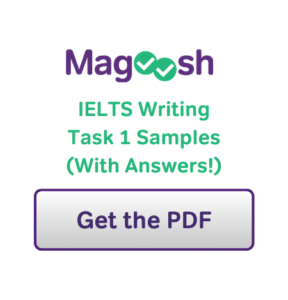
Note that all the IELTS Writing Task 1 samples are model essays for a band 9 IELTS score. The line graph sample prompt includes a detailed scoring explanation. You can learn more about scores for IELTS Writing Task 1 by consulting the official IELTS rubric .
- Take a good look at our guide to IELTS Writing Task 1 paragraph structure . The guide tells you everything you need to know about how Writing Task 1 essays and paragraphs should be structured, with an example question and model essay.
IELTS Writing Task 1 Samples: The Major Question Types
Below are questions for each common infographic in IELTS Writing Task 1: bar charts, pie charts, line graphs, process diagrams, and maps.
IELTS Academic Writing Task 1: Line Graph with Model Answer and Scoring Explanation
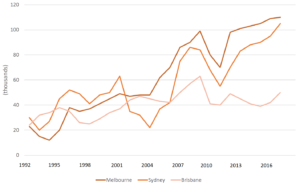
[/threecol_one_last]
IELTS Academic Writing Task 1: Bar Chart With Model Answer
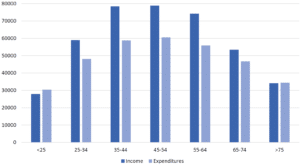
Pie Chart with Model Answer
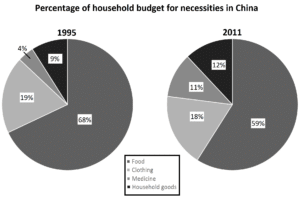
Process Diagram with Model Answer
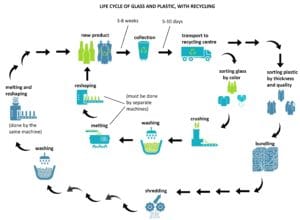
IELTS Academic Writing Task 1: Map with Model Answer
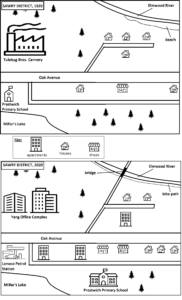
IELTS Academic Writing Task 1: Two Different Types of Graphics
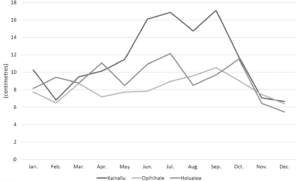
[/threecol_two][threecol_one_last]
Additional Resources for Writing Task 1
Now that you’ve seen some models for how this task is done, you should be ready for some real practice! Here are some resources from Magoosh that should help.
- Practicing using these common IELTS Writing Task 1 and Task 2 linking words .
- Familiarize yourself with the test with IELTS Academic Writing Task 1: Ultimate Guide video , and use a Writing diagnostic quiz to assess your current strengths and weaknesses.
- Use study schedules to help you find time to study and stay motivated. To help you organize your time, use this IELTS study schedule if you only have a week to go before you will take the IELTS. If you have a month, this one month IELTS study schedule offers more extended practice.
- Find high-quality study materials. We offer a huge collection of study reources for the whole IELTS Writing seciton ! Don’t forget about Magoosh IELTS Prep which includes lessons on IELTS Writing Task 1 (and all other sections of the exam!) to help you prep smarter. In addition to many video lessons and practice essays, the 6-month plan allows students to get feedback and scoring on four practice IELTS Writing essays; the 1-month plan includes feedback on one essay. You can also browse more recommended books and resources !

David is a Test Prep Expert for Magoosh TOEFL and IELTS. Additionally, he’s helped students with TOEIC, PET, FCE, BULATS, Eiken, SAT, ACT, GRE, and GMAT. David has a BS from the University of Wisconsin-Eau Claire and an MA from the University of Wisconsin-River Falls. His work at Magoosh has been cited in many scholarly articles , his Master’s Thesis is featured on the Reading with Pictures website, and he’s presented at the WITESOL (link to PDF) and NAFSA conferences. David has taught K-12 ESL in South Korea as well as undergraduate English and MBA-level business English at American universities. He has also trained English teachers in America, Italy, and Peru. Come join David and the Magoosh team on Youtube , Facebook , and Instagram , or connect with him via LinkedIn !
View all posts
More from Magoosh

Leave a Reply Cancel reply
Your email address will not be published. Required fields are marked *
IELTS Charlie
Your Guide to IELTS Band 7
IELTS Writing Task 1: The Essential Study Guide
Welcome to my complete guide to IELTS Writing Task 1 . In this guide you will find out what you have to do, the different question types, and how to write a great piece of writing for Task 1.


IELTS Writing Academic Task 1
In IELTS Academic Writing Task 1, you need to write a short report about some information presented in a visual form. In other words, you need to turn visual information into a text.
How is IELTS Writing Task 1 assessed?
IELTS examiners will assess you in four different areas, each of which make up 25%of the total mark.
- Task Achievement
- Coherence and Cohesion
- Lexical Resource
- Grammatical Range and Accuracy
Here are some of the most common types of visual information given in task 1 of the IELTS writing test.

In a bar chart, you will often be asked to write a report which compares 2 things . In the above graph, you should describe differences at 2 different times (1992 and 2000) and also differences between the IT and service industries.
Read my sample answer for this bar graph question.

A line graph is similar to a bar chart, except you should describe trends (changes over a period of time). In the above line graph you should compare the changing trends between 1975 and 2000, and the differences between the three types of fast food.

In a pie chart you may be given 2, 3 or 4 things to compare. In the above example you should compare revenue sources and expenditure types.
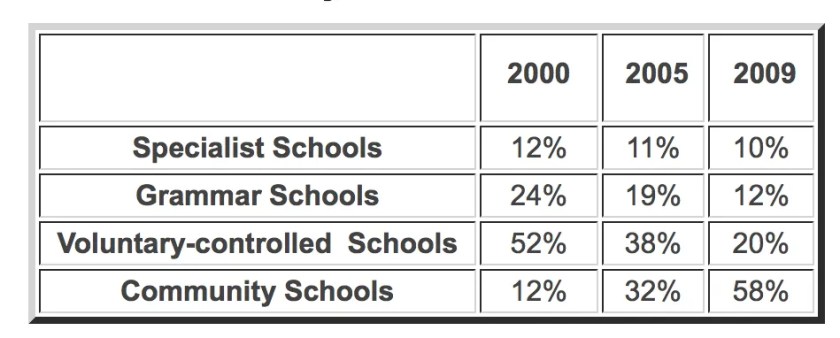
In a table you will again compare at least 2 different things. Sometimes, a table will not include changes over time. In the above example you should compare the changes over time in different types of school.
In a map question, you also have to describe some visual information, but it might not involve comparing different things. In the above example you have to compare the locations of different sites for a proposed shopping centre, in relation to different map features.
Process Diagram

A process diagram is a completely different type of Task 1 question. You describe a process rather than change. In the above example you should describe the brick manufacturing process.
IELTS Writing General Training Task 1
In the General Training IELTS, you write a letter in response to a certain situation. For example, you might have to write:
- a request for information
- a complaint
In Task 1 you must write at least 150 words. Ideally, try to write between 170 and 180 words. Read what happens if you go below the word count .
Here is some vocabulary you should try to use in your Task 1 letter .
How do I write an Academic IELTS Writing Task 1?
There are 3 things you need to include in your report:
- An introduction to the graph
- An overview of the graph
- The main details in the graph
Introduction
In your introduction, you describe the subject of the graph, chart or diagram. You should do this by writing, in your own words, the information in the question, title and x/y axes of the graph. When you write something in your own words, you are paraphrasing. IELTS examiners love good paraphrasing!
In the overview you describe the big picture – the main trends, or patterns in the data. But don’t refer to actual data.
Main Details
Then you describe the main details of the graph, chart or diagram in 2 to 3 paragraphs. You need to refer to the data here, but not every single item of data- just the ones that support the overview you gave in the previous chapter.
Read how I use this structure to answer a question about a bar chart .
IELTS Writing Walkthroughs
In the videos below, I write an IELTS Writing Task 1 report in real-time. I take you through the thought process behind writing a good IELTS report, so you can see how I do it.
Share this:
- Click to share on Facebook (Opens in new window)
- Click to share on WhatsApp (Opens in new window)
- Click to share on Twitter (Opens in new window)
- Click to share on LinkedIn (Opens in new window)
- Click to share on Reddit (Opens in new window)
- Click to share on Pinterest (Opens in new window)
- Click to share on Telegram (Opens in new window)
- Click to share on Pocket (Opens in new window)
- Click to print (Opens in new window)
- Click to share on Tumblr (Opens in new window)
Related Posts

About the author
Charlie is a former IELTS Examiner with 25 years' teaching experience all over the world. His courses, for both English language learners and teachers, have been taken by over 100,000 students in over 160 countries around the world.
4 thoughts on “IELTS Writing Task 1: The Essential Study Guide”
Thanks for sharing such a great information.
Dear Charlie, Thanks for your great website. I need a copy of the ebook “The essential guide to the IELTS”. Thanks
I am regular visitor, how are you everybody? This piece of writing posted at this site is genuinely good.
Leave a Reply Cancel reply
IELTS® is a registered trademark of Cambridge English Language Assessment, the British Council, and IDP Education Australia. By using this website, you agree that you fully understand that ieltscharlie.com is not affiliated, approved or endorsed by Cambridge English Language Assessment, the British Council, or IDP Education Australia.
Unit 22489, PO Box 6945, London, W1A 6US, United Kingdom
© IELTSCharlie
Privacy Overview
Discover the 7 STEPS to BAND 7 in IELTS Writing Task 2
- A Beginner’s Guide to IELTS
- Common Grammar Mistakes [for IELTS Writing Candidates]
Writing Correction Service
- Free IELTS Resources
- Practice Speaking Test
Select Page
How to Structure IELTS Writing Task 1 Essays
Posted by David S. Wills | Aug 24, 2020 | IELTS Tips , Writing | 1
I have written many times about structure on this website, but mostly I have focused on task 2 . Today, however, I am going to take some time to show you how to structure IELTS writing task 1 essays . This often seems like a mystery but in fact it is quite simple and you can usually follow a pretty basic template.
I am going to divide this lesson into two parts. First, we will deal with the IELTS Academic exam and then we will look briefly at the IELTS General exam because these require different structures. Also, keep in mind that IELTS academic writing includes line graphs, pie charts, bar charts, maps, and more, so each of these might require some changes to the essay structure.
IELTS Academic Writing Task 1 Structure
When you do IELTS academic writing task 1, you may find yourself presented with one (or more) of the following:
- Process diagram
These require quite different language but generally you can apply a similar essay structure to all of them. Whether you are writing about a line graph or a table, you can pretty much use this IELTS writing task 1 template :
Let’s establish what “group of information” means
When you are doing IELTS Academic writing task 1, you need to examine the data and then describe it. To do this, you cannot just take a random approach and write about the different features of the data. Instead, you need to highlight the important parts.
This can be difficult, so let’s take an example.
In this line graph, we only have two lines to write about. Clearly, we could write one paragraph about men and one paragraph about women. Easy! Our structure would look like this:
To be honest, that is a very, very easy graph to describe so it was not a challenge. Let’s choose something more difficult to explore:
This is not a terribly difficult line graph to describe, but it presents a challenge for our IELTS writing task 1 structure template. How should we group these three lines?
One option is to structure it like this:
Another option is to break the information down according to time:
Grouping by Time vs Grouping by Type
The easiest way to group data for IELTS writing task 1 is to put them into different types. For example, in this line graph about a Caribbean island, we could potentially describe the number of people who stayed on the island in one paragraph and then the people who stayed on the ships in another paragraph.
But is this the best way?
When you write an essay with that structure, it becomes harder to compare the data. Remember that your question will always say “make comparisons where relevant.”
This suggests that grouping by time is better for one major reason: You can compare the different types of data over time. In this case, we can see the two sets of data are opposites, which gives us a great chance to make comparisons.
Sample Essay
Here is my sample essay about the Caribbean island.
The line graph displays the numbers of tourists that visited an unnamed Caribbean island between 2010 and 2017. The tourists are divided into two groups – those staying on cruise ships and those staying on the island itself – and these had a loosely inverse correlation. The total number of visitors, however, rose more or less continuously throughout the eight-year period. In the first year recorded, which was 2010, there were about twice as many tourists staying on the island as those staying on cruise ships. A year later, the number staying on cruise ships doubled to a half million, but this dropped back to around a quarter million in 2012. When the figures for tourists on cruise ships dropped, the number staying on the island rose quickly and over the coming few years, as this sudden increased levelled off, the number of people who stayed onboard their ship continued to grow again. Between 2012 and 2017, there were more and more visitors staying on cruise ships. From just a quarter million, this rose to two million, while the figures for those on the island levelled off at just one and a half million and then dropped slightly in the penultimate year, before finishing at one and a half. This meant that, for the final two years, more tourists stayed on cruise ships than on the island.
Can you write more than 3 paragraphs?
I would like to make clear that there is no such thing as the correct IELTS writing task 1 essay structure. It is possible to write a great essay with 2 paragraphs, but it is also possible to do it with 4 paragraphs. I would not recommend writing more than 4 paragraphs and I would certainly not recommend writing just 1! This would show a total lack of understanding of Coherence and Cohesion.
(P.S. – Read all about the number of paragraphs for IELTS writing task 2 here .)
Anyway, let’s look at an example of an essay that might be best described with 4 paragraphs:
For this task, we have to decide how to group the data. I personally find that the trend for burglary is more interesting than the others because it has much more of a change, which tells me that it should be described first. You could definitely write a paragraph that grouped car thefts and robberies together, but one is much more common than the other, so it might not work well.
I would take this approach:
Of course, writing this much could mean taking a long time and potentially not finishing your essay. I have written an article about how many words you should write for IELTS, which you can read here .
Sample Essay – 4 Paragraphs
Ok, let’s look at the essay I wrote about crime rates in Newport.
The line graph shows changes in crime rates over a ten-year period in the city centre of Newport. Three types of crimes are listed, two of which ended the period at roughly similar levels to where they began, and one experienced a major drop. In 2003, which was the beginning of the recorded period, burglary was the most common type of crime in Newport, with just under 3,500 cases reported. This rose slightly the following year, before entering into a long downward trend, reaching a low of about 1,200 in 2008. After this, the number of burglaries reported fluctuated until 2012. The number of car thefts was about 2,800 in 2003, and ended the period slightly lower, at 2,700. During the decade-long period, it fluctuated, reaching low points in 2006 and 2008. Car theft was the second most common type of crime in 2003, but the fall in burglaries meant that from 2008 onwards, they were the most common crime in Newport. Robberies were the least common crime and followed a somewhat similar trend to that of car thefts, starting and ending the period with around 700 incidents. It fluctuated only slightly during the ten-year period.
IELTS Writing Task 1 Pie Chart Structure
The previous examples were both line graphs because these are the most common type of IELTS academic writing task 1 question. However, in order to ensure you understand fully, I will also include a pie chart and show you how to structure your essay.
This is actually the most difficult IELTS writing task 1 question I have ever seen!
So how could we produce an IELTS writing task 1 essay structure to fit this?
The obvious choice seems to be writing 3 paragraphs, with 1 paragraph for each of the pie charts. That’s sensible, right?
Well, personally I think that would make it harder to draw comparisons between these data. Instead, I will group the data in terms of meals . I will look at the main meals in one paragraph and then snacks in a final paragraph. This allows me to compare all 3 nutrients!
My structure would then look like this:
**Please note that this is a quite advanced structure and it is difficult to do. I am including it to show you how it is possible to take various approaches and produce a great essay.
Sample Answer
This is my answer to the very difficult question about nutrients:
The pie charts show information about three different kinds of nutrients and their prevalence in typical American meals. There are four kinds of meal mentioned, including snacks. The figures for sodium and saturated fat are loosely similar, but for added sugar they are quite different. Sodium and saturated fat are both extremely common in typical American dinners. According to the pie charts, 43% of sodium is consumed at dinner time as well as 37% of saturated fat, but just 23% of added sugar is found in American dinners. Almost a third of sodium eaten by Americans is consumed at lunch, alongside more than a quarter of saturated fat. Breakfasts contain the lowest amount of these potentially unhealthy ingredients, at 14% sodium and 16% for both saturated fat and added sugar. The figures for snacks look quite different. More than four tenths of the added sugar consumed by Americans came from snacks, which also contained a fifth of the saturated fats and about a sixth of sodium.
IELTS General Training Writing Task 1 Structure
When you take the IELTS General Training (GT) writing test, you will see that task 1 requires you to write a letter. As such, there is no “recommended essay structure” that you can use.
Instead, you should aim to write a letter that follows typical letter-writing conventions and to use paragraphs logically to guide your reader.
How can you structure an IELTS general writing task 1 letter?
I would strongly recommend this sort of approach:
Of course, I will say here that you should not take this as a 100% perfect letter template . It is merely a suggestion and you should pay close attention to the actual task you are assigned. This template can usually be adapted to make a good letter, but sometimes you need to add or combine paragraphs. Also, we might have a short paragraph at the start and/or end of the essay to give some friendly greeting or send some kind regards.
For one thing, sometimes you need to give much more weight to one part of the question, which could require using two paragraphs for that and one for the other parts. An example would be:
How to Adapt an IELTS General Writing Task 1 Format Structure
The people who score band 8 or 9 in IELTS writing are not the ones who memorize structures and vocabulary, or who attempt to predict the questions they will encounter. Instead, these are people who can learn from others but create their own essays and letters by adapting good ideas to the present situation.
Let’s look at an example question from IELTS GT writing task 1.
A large company in your area has decided to spend a certain amount of money, either to sponsor a local children’s sports team for two years, or to pay for two open-air concerts. It has asked for feedback from the general public. Write a letter to the company. In your letter, – describe the benefit of sponsoring the sports ream – summarise the benefits of paying for the concerts – say how you think the company should spend the money
How can we structure a reply to this task?
I am going to use the IELTS general writing task 1 format structure that I suggested above, with two paragraphs of explanation in the middle because there are two sides to the issue. My structure would look like this:
Here is my sample answer to the above question:
Dear Sir or Madam, I am writing in response to your request for input on the decision about either spending money on a sports team or for two open-air concerts. Firstly, if you were to sponsor the children’s sports team, it would obviously be a great investment in the community. Nothing is more important to us than our children’s health and happiness. If you decided to sponsor the football team, this would mean a tremendous amount to many families. The concerts would also be beneficial in bringing the community together in a big event. This would foster some positive experiences and allow people to have fun together doing something they don’t normally do. It might also be good for local businesses. It is my opinion that you invest the money in the sports team as I think this would have the greatest benefit. For two whole years, parents would be able to watch their children play sports, and that is much better than going along to two concerts. Sincerely, David Wills
More Resources
This is a massive topic to cover and so I suggest that you continue reading once you are finished with this article. I have countless lessons on this website about IELTS writing task 1 (both academic and general) that you can read. I also have an IELTS writing task 1 template PDF file here .
More articles about structure:
- How to Describe a Bar Chart
- 7 Steps to Structuring an IELTS Essay
- How to Describe a Process Diagram
About The Author
David S. Wills
David S. Wills is the author of Scientologist! William S. Burroughs and the 'Weird Cult' and the founder/editor of Beatdom literary journal. He lives and works in rural Cambodia and loves to travel. He has worked as an IELTS tutor since 2010, has completed both TEFL and CELTA courses, and has a certificate from Cambridge for Teaching Writing. David has worked in many different countries, and for several years designed a writing course for the University of Worcester. In 2018, he wrote the popular IELTS handbook, Grammar for IELTS Writing and he has since written two other books about IELTS. His other IELTS website is called IELTS Teaching.
Related Posts
What Are the Common Mistakes when Taking IELTS?
February 5, 2018
Two Difficult IELTS Letters [Useful Advice]
January 3, 2022
8 IELTS Reading Tips
January 24, 2022
3 Great Ways to Get More IELTS Speaking Practice
February 17, 2019
I liked the course very much. It extended my knowledge about IELTS task 1 essay writing. This article is very insightful, points well explained and use of tutorials and examples to give a more clear picture of how task 1 essay should be tackled. Thanks for the great post! I liked how detailed and helpful it is.
Leave a reply Cancel reply
Your email address will not be published. Required fields are marked *
This site uses Akismet to reduce spam. Learn how your comment data is processed .
Download my IELTS Books
Recent Posts
- Past Simple vs Past Perfect
- Complex Sentences
- How to Score Band 9 [Video Lesson]
- Taxing Fast Food: Model IELTS Essay
- Airport Vocabulary
Recent Comments
- Daisey Lachut on IELTS Discussion Essays [Discuss Both Views/Sides]
- David S. Wills on Describe a Historical Period
- Siavash on Describe a Historical Period
- fabliha on IELTS Speaking Partners
- tufail khan on IELTS Discussion Essays [Discuss Both Views/Sides]
- Lesson Plans
- Model Essays
- TED Video Lessons
- Weekly Roundup
Free IELTS lessons signup

- Academic practice
- General practice
- Task 1 Academic
- Task 1 General
- Task 2 (essay)
Task 1-A samples with tips and answers
Sample 1 Pie chart
Sample 2 Diagram
Sample 3 Line graph
Sample 4 Bar chart
IELTS Academic Writing Task 1
In this task you will be presented with a graph, table, chart or diagram and asked to describe, summarise or explain the given information.
How to answer IELTS Academic Task 1?
1) Analyse the graph
Firstly, you need to get an overview of the graph/chart/diagram you will describe. Look for general trends, changes and key features to get an idea of how you will structure the information.

- Car was the most popular type of transport in all countries, except for Germany.
- In Great Britain and USA, there are big differences between percentages of people who choose some kind of transport.
- In Germany, percentages of people who choose car and bicycle are roughly the same.
- In France, percentages of people who choose motorcycle and bicycle are nearly equal.
- Motorcycle was the least popular type of transport in all countries, except for the USA.
- Overall, car is the most chosen transport, bicycle is on the second place and motorcycle is the least chosen transport.
2) Write an answer with the following structure:
Once you've thought out all patterns on the graph, you can start writing your answer.
You can learn more about how to answer Writing task 1 .
Don't forget to use special vocabulary to describe graphs and linking structures . Also use words from academic wordlist .
Don't worry if you think there is too much or not enough information!
Remember that the purpose of Academic Task 1 is to test your ability to distinguish and describe the changes and trends you see on the graph.
If you think that there is not enough information on the graph to write 150 words: don't panic! Write in detail about every single alteration and support your writing with a lot of data.
If you think that there is too much information on the graph: also don't panic! Don't ornately depict each change on the graph, but try to see a few main trends instead.
- IELTS Scores
- Life Skills Test
- Find a Test Centre
- Alternatives to IELTS
- Find Student Housing
- General Training
- Academic Word List
- Topic Vocabulary
- Collocation
- Phrasal Verbs
- Writing eBooks
- Reading eBook
- All eBooks & Courses
- Task 1 Lessons & Tips
IELTS Writing Task 1: Lessons, Tips and Strategies
In the IELTS writing Task 1 for academic you have to describe some kind of graph, diagram, map or process.
Here you will get all the tips and techniques you will need for writing about the Task 1, or to find out how to improve your score if it has been too low.
Taking General Training? - IELTS Letter Lessons

IELTS Writing Task 1 Lessons:
How to Write an Academic IELTS Task 1 This starter lessons tells you in simple steps how to structure and write a basic IELTS Graph.
Types of Graph
Graphs Over Time This important lesson shows you what you must do to properly describe a graph or chart that has a period of time.
IELTS Pie Chart In this lesson you'll learn how to write about a pie chart, with tips on how to best organize your answer and advice on the language to use.
IELTS Process In this lesson you'll learn how to describe an IELTS process diagram, with information about organizing your answer and using the passive voice.
Two graphs together Sometimes you get two graphs to describe together. This lessons shows you how to organize your answer if you do.
IELTS Tables This lesson provides you with IELTS practice for tables. It shows you that tables are not that different from other types of graph.
Task 1 Language
Language of Change This lesson explains some useful sentence structures using some common language of change and you can practice the words with a gap fill.
Language to Compare and Contrast Compare and contrast language is needed for most graphs and diagrams so it is important to learn and practice it.
A Common Mistake This lesson takes you through a mistake that is common when describing graphs in Task 1.
Using Prepositions Learn how to use the right prepositions when you are using the language of change in a graph over time.
Describing graphs in the future Sometimes you may be given a graph to describe that is predicting what will happen in the future. View some strategies on how to approach a task 1 like this.
Tenses for graphs, processes, and maps This lesson gives you tips on the types of tenses you should know for the various types of task you could be given.
Task 1 Quizzes Try out these quizzes which give you fun practice or a chance to test your knowledge of the variety of language used for academic task 1.
Organisation
Organizing a Line Graph (Part 1) Find out about how there is more than one was to organize a task 1 graph, and learn how to write about a graph divided into 'age groups'.
Organising a Line Graph (Part 2) If you want to achieve a high band score for your graph you must ensure it is well-organised. This lesson tells you more about one possible way of doing this.
Overview of Academic Task 1:
Task 1 Quiz Exercises:
Check out our IELTS Quiz page for various interactive quizzes to test and teach yourself about the language for the IELTS writing task 1:
- IELTS Task 1 Quizzes
IELTS Writing Forum:
The writing forum is a place for you to discuss the test or ask questions about it. Reading previous questions asked may help you with things you don't understand so check out the forum here:
- IELTS Writing Task 1 Forum
These are some useful topics and questions that have already been discussed:
- How should I paragraph in IELTS writing task 1?
- How do I organise my graph?
- What tenses do we use in the Task 1?
- What happens if I didn't finish my graph?
And remember you can ask your own question if there is something in the test that you are unsure about.
Any comments or questions about this page or about IELTS? Post them here. Your email will not be published or shared.
Before you go...
Check out the ielts buddy band 7+ ebooks & courses.

Would you prefer to share this page with others by linking to it?
- Click on the HTML link code below.
- Copy and paste it, adding a note of your own, into your blog, a Web page, forums, a blog comment, your Facebook account, or anywhere that someone would find this page valuable.
Band 7+ eBooks
"I think these eBooks are FANTASTIC!!! I know that's not academic language, but it's the truth!"
Linda, from Italy, Scored Band 7.5

IELTS Modules:
Other resources:.
- All Lessons
- Band Score Calculator
- Writing Feedback
- Speaking Feedback
- Teacher Resources
- Free Downloads
- Recent Essay Exam Questions
- Books for IELTS Prep
- Student Housing
- Useful Links

Recent Articles
Alternatives to the IELTS Exam
Mar 22, 24 12:32 PM
Common Questions about the IELTS Speaking Test
Mar 09, 24 05:28 AM
IELTS Computer Delivered Practice Tests Plus Band Score
Mar 01, 24 02:38 AM
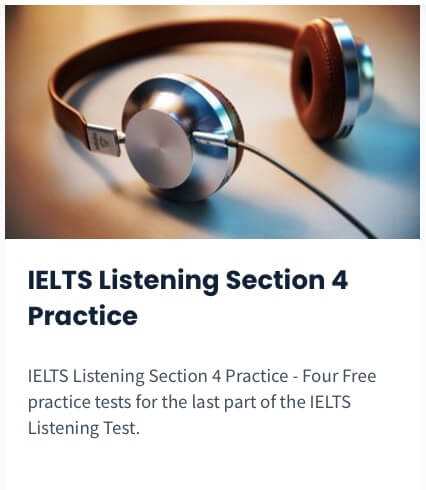
Important pages
IELTS Writing IELTS Speaking IELTS Listening IELTS Reading All Lessons Vocabulary Academic Task 1 Academic Task 2 Practice Tests
Connect with us
Copyright © 2022- IELTSbuddy All Rights Reserved
IELTS is a registered trademark of University of Cambridge, the British Council, and IDP Education Australia. This site and its owners are not affiliated, approved or endorsed by the University of Cambridge ESOL, the British Council, and IDP Education Australia.
- Ebooks & Courses
- Practice Tests
IELTS Academic Writing Task 1 – How To Understand & Analyse Task 1 Questions –
There are 5 steps to writing a good essay for IELTS Academic Writing Task 1:
- Analyse the question
- Identify the main features
- Write an introduction
- Write an overview
- Write the details paragraphs
One of the biggest mistakes many students make is missing out the first step – analysing the question.
They are so worried about getting their essay finished in the 20 minutes allowed for the task that they get straight down to writing without fully understanding the question. The result is an essay that fails to meet many of the marking criteria and thus achieves a low score.
Whilst your language skills may be good enough to earn you a Band 7 or 8, not answering the question appropriately could reduce your score to a Band 6 or even lower.
It’s not difficult to analyse and understand task 1 questions once you know how and that’s what you’re going to learn in this lesson.
Understanding the Question
The first thing to understand is that the format of every question in IELTS Academic Writing Task 1 is the same.
Here’s a typical question. The highlighted words are always the same no matter what type of question you get.
The bar chart below shows numbers of seals, whales and dolphins recorded in the Gormez Straits from 2006 to 2018.
Summarise the information by selecting and reporting the main features, and make comparisons where relevant.
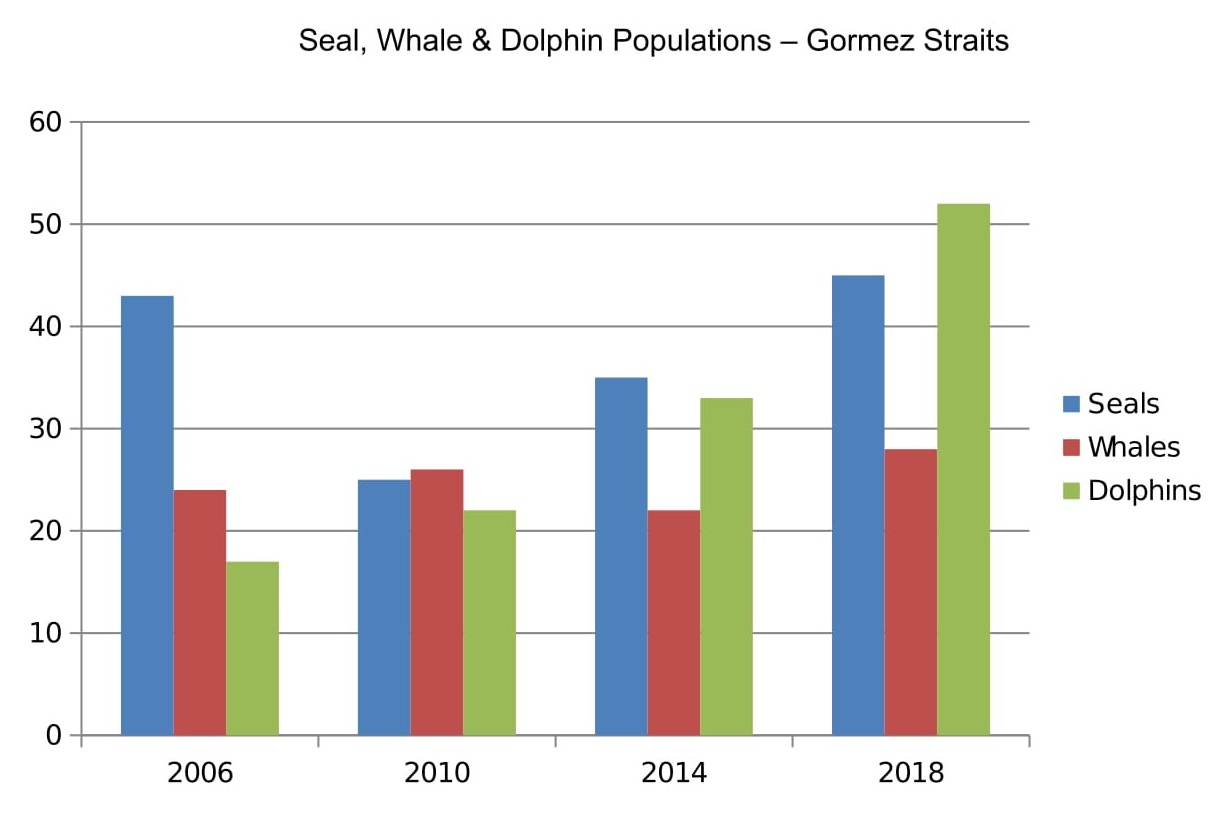
Every question consists of:
- A brief description of the graphic
- The instruction
- The graphic – chart, graph, table, etc.
So, let’s analyse what you have to do. For this, we need to look at the ‘instruction’ sentence.
You have to do 3 things:
1. Select the main features.
2. Write about the main features.
3. Compare the main features.
This is the same for every question and every type of graphic.
You’ll notice that each part of the task refers to the ‘ main features ’ of the graphic. You do not have to write about everything.
A key skill you must learn is how to quickly pick out the features.
Another point to note is that you are not required to give your opinion as you would for many Task 2 essays. This is a common mistake which will lose you marks. Only write about what you can see in the graphic.
Identifying the Main Features
I’m now going to give you some checklists to help you to identify the main features of the different types of IELTS Academic Writing Task 1 questions.
I go into detail on how to pick out the main features in specific questions in the lessons on individual question types.
Here are the 7 question types:
- Table Chart
- Process Diagram
- Multiple Graphs
Click the links for step-by-step instructions on how to write each type of essay including a model answer.
The various types of graphs and charts are not especially difficult to interpret. The challenge for most students is simply that they are not used to working with them.
Remember, IELTS is an English exam designed to test your language skills, not your mathematics ability. No complicated calculations are required.
The graphics are just a way of presenting information using numbers and diagrams. Your job is to convert the information into a written form. That’s all you have to do.
Bar Charts & Line Graphs
1) What can you learn from the title?
There won’t always be a title but where there is, read it carefully as it will give you important information about the chart or graph and the first clue as to what it's about.
In our example above, the bar chart shows ‘Seal, Whale & Dolphin Populations in the Gormez Straits’.
2) What information do the 2 axes give?
The chart or graph will have a vertical axis and a horizontal axis, often called the ‘x’ and ‘y’ axes.
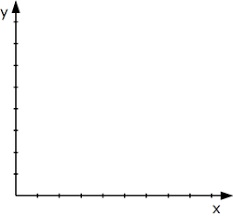
Each gives a different type of information. In our example, the x axis tells us the years in which the numbers of seals, whales and dolphins were recorded, and the y axis shows how many were recorded.
3) What are the units of measurements?
These could be many different things, for example, amount, time, age, %. The measurements on our example bar chart are the amount in single numbers and time in years.
Occasionally, the units won’t be given but you will be able to work out what they are either from the title of the chart or other information it includes.
4) What is being compared?
Usually, IELTS Academic Writing Task 1 questions ask you to compare two or more groups of things. They could include almost anything. In our sample question, we are asked to compare three types of marine mammals.
Very often, you will have to compare what happens over a period of time.
5) What are the time periods?
Is the data from the past, the present or the future? Often it will be two or all three of these. This is very important to note because it will determine what tense or tenses you should use.
The data in our sample bar chart is all in the past.
6) What is the most obvious trend?
You should look for any clear increases or decreases in the data. They could be gradual or sharp changes.
7) Are there any notable similarities?
As well as noting marked increases and decreases, you also need to look out for things that are similar or stay the same over a period of time.
You can download a PDF of all the checklists, without the explanations, on this page: Task 1 Checklists .
Use them as you practice writing IELTS Academic Writing Task 1 essays.
Many students fear tables more than any other type of graphic because they’re just sets of numerical data without any visual representation. However, they are not as complicated as they may at first look.
The key to understanding them is to use the clues given in the title , the row and column headings and the units of measurement .
For example, the title of the table below tells us that it shows changes in world population from 1950 to projected levels in 2050.
Rows and columns – The world is divided into continents (Africa, Asia, etc.) and data is given for three specific years: 1950, 2000 and projected data for 2050.
In the first table, the units of measurement is billions of people and in the second table, percentages of the total world population are used.
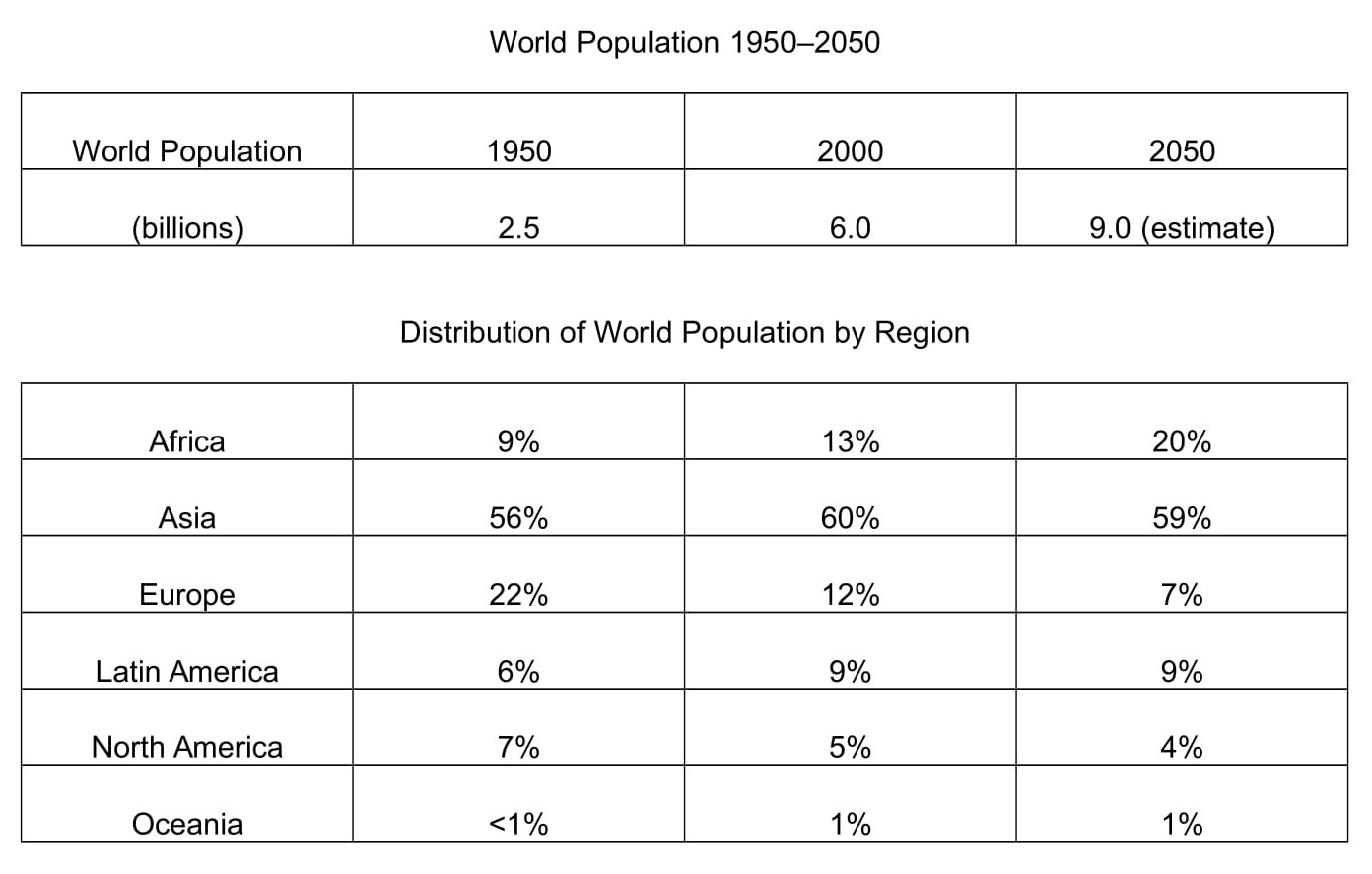
All the same questions in the checklist for bar charts and line graphs are relevant to tables except for question 2 about the x and y axes. Apart from this, analyse the data in the same way.
Click this link for step-by-step instructions on how to answer this question including a model answer:
Table Chart – Instructions & Model Answer
Pies charts feature regularly in IELTS Academic Writing Task 1. They always show percentag es or proportions. Apart from that, they are essentially the same as bar charts and line graphs in that they are another way of presenting data visually.
As with tables, the same checklist of questions can be used to analyse them, with the exception of question 2 about the x and y axes.
Pie charts generally have titles and labels or sometimes a key instead of segment labels as in the sample question below. The key explains what each segment of the pie chart represents.
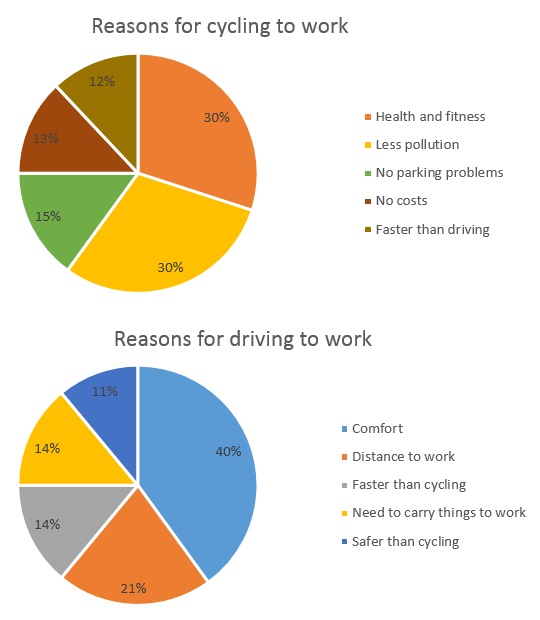
Source: Official website IELTS Essentials
Pie Chart – Instructions & Model Answer
Process Diagrams
Now we move on to a very different type of graphic – the process diagram.
Here’s a checklist of questions you can ask to help you analyse and understand them.
1) Is it a linear or a cyclical process?
A linear process starts and finishes at different places. It will often involve the manufacture or creation of something, with raw materials going in at one end and the finished product coming out the other end.
A cyclical process is a process that goes back to the beginning and repeats over and over again, such as the life cycle of a frog.
Lineal process
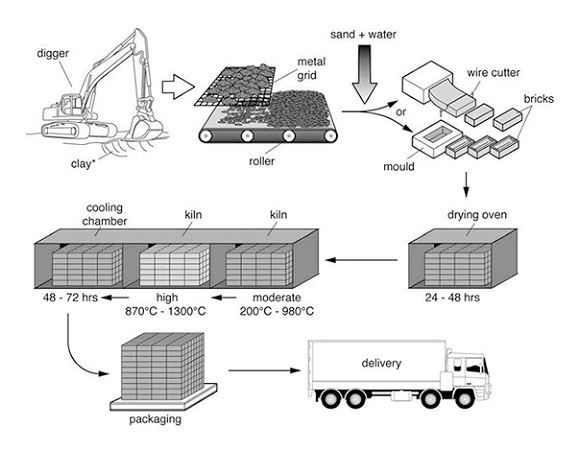
Source: IELTS past paper
Cyclical process
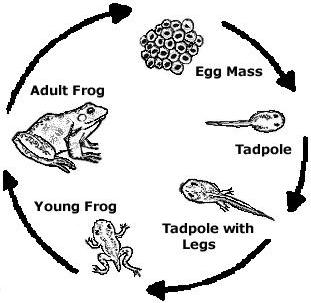
2) Where does the process start and end?
For a lineal process, this will usually be obvious. It may be harder to determine for a cyclical process so it’s important that you examine the graphic carefully to find out.
3) How many steps are there to the process?
If there are a lot, it can be helpful to number them from 1 to whatever number the final stage is.
4) Can the process be easily broken down into stages?
In the brick-making graphic, for example, there are three stages:
a) Creating the bricks from clay
b) Manufacturing the finished product by drying and firing
c) Packaging and delivery
In the life cycle graphic, there are also three distinct stages where the frog is at different stages of development – egg, juvenile, adult.
5) What are the raw materials? What is produced at the end of the process?
These questions obviously apply only to manufacturing processes.
For other types of process, it might be more appropriate to ask the following question.
6) What is the end result of the process?
The graphic below shows a different type of process, more of a system, and this question would certainly be helpful to ask here. The end result is the production of electricity.
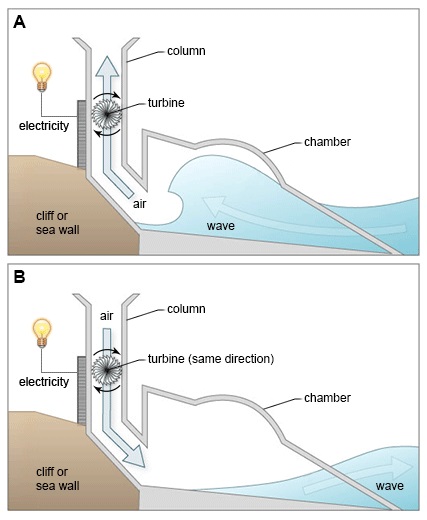
Process Diagram – Instructions & Model Answer
For IELTS Academic Writing Task 1 questions about maps, you will normally be asked to compare two or three maps of a place over a period of time as in this question.
The maps could be from the past or the present. Occasionally you’ll get a map of a proposed development in the future.
Map questions are some of the easiest to answer because the information is very clear, it doesn’t involve numbers and it needs little interpretation. However, I have a short checklist of questions you can ask to help you analyse and understand them.
1) What time periods are shown?
Is the data shown from the past, the present or the future? This is important to note because it will determine whether you should write in the past, present or future tense.
The two m aps below show the village of Stokeford at two different times in the past.
2) What are the main differences between the maps?
What features have disappeared? What new features are in their place?
3) What features have remained the same over the time period?
Although the location on the maps will have undergone major development, some features will probably remain unchanged.
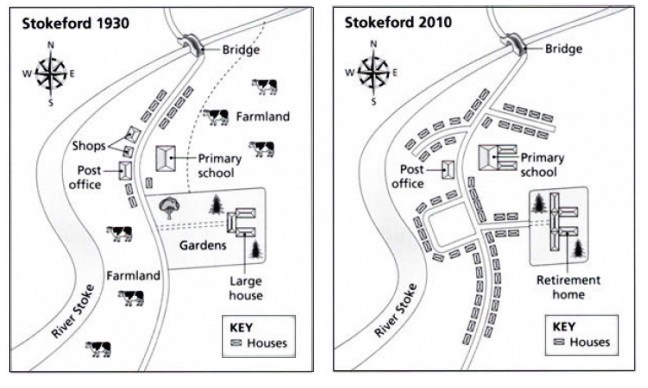
Maps Essay – Instructions & Model Answer
Here’s the link to the checklists again: Task 1 Checklists
The next step to writing a high-scoring essay for IELTS Academic Writing Task 1 is to learn how to plan your essay using an easy to remember 4 part structure. You’ll find the lesson here: How To Plan a Task 1 Essay
Want to watch and listen to this lesson on IELTS Academic Writing Task 1?
Click on this video.
Would you prefer to share this page with others by linking to it?
- Click on the HTML link code below.
- Copy and paste it, adding a note of your own, into your blog, a Web page, forums, a blog comment, your Facebook account, or anywhere that someone would find this page valuable.
Like this page?
Ielts academic writing task 1 – all lessons.
IELTS Academic Writing – A summary of the test including important facts, test format & assessment.
Academic Writing Task 1 – The format, the 7 question types & sample questions, assessment & marking criteria. All the key information you need to know.
Understanding Task 1 Questions – How to quickly and easily analyse and understand IELTS Writing Task 2 questions.
How To Plan a Task 1 Essay – Discover 3 reasons why you must plan, the 4 simple steps of essay planning and learn a simple 4 part essay structure.
Vocabulary for Task 1 Essays – Learn key vocabulary for a high-scoring essay. Word lists & a downloadable PDF.
Grammar for Task 1 Essays – Essential grammar for Task 1 Academic essays including, verb tenses, key sentence structures, articles & prepositions.
The 7 Question Types:
Click the links below for a step-by-step lesson on each type of Task 1 question.
- IELTS Writing
- Academic Task 1 - Understand & Analyse
- Back To Top
* New * Grammar For IELTS Ebooks
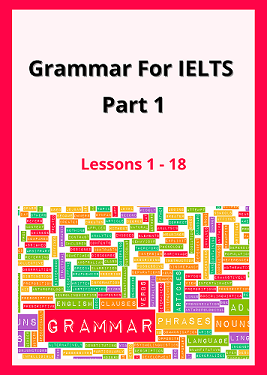
$9.99 each Full Set Just $ 23.97
Find Out More >>
IELTS Courses

Full details...

IELTS Writing Ebook
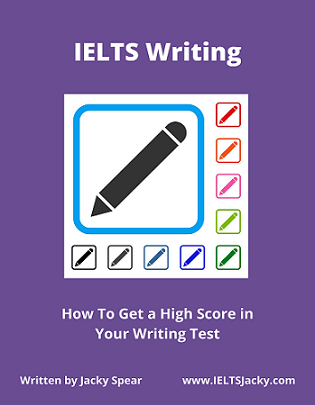
Discount Offer
$7 each Full Set Just $ 21

Find out more >>
Testimonials
“I am very excited to have found such fabulous and detailed content. I commend your good work.” Jose M.
“Thanks for the amazing videos. These are ‘to the point’, short videos, beautifully explained with practical examples." Adari J.
"Hi Jacky, I bought a listening book from you this morning. You know what? I’m 100% satisfied. It’s super helpful. If I’d had the chance to read this book 7 years ago, my job would be very different now." Loi H.
"Hi Jacky, I recently got my IELTS results and I was pleased to discover that I got an 8.5 score. I'm firmly convinced your website and your videos played a strategic role in my preparation. I was able to improve my writing skills thanks to the effective method you provide. I also only relied on your tips regarding the reading section and I was able to get a 9! Thank you very much." Giano
“After listening to your videos, I knew I had to ditch every other IELTS tutor I'd been listening to. Your explanations are clear and easy to understand. Anyways, I took the test a few weeks ago and my result came back: Speaking 7, listening 9, Reading 8.5 and Writing 7 with an average band score of 8. Thanks, IELTS Jacky." Laide Z.
Contact
About Me
Site Map
Privacy Policy
Disclaimer
IELTS changes lives.
Let's work together so it changes yours too.
Copyright © 2024 IELT Jacky
All Right Reserved
IELTS is a registered trademark of the University of Cambridge, the British Council, and IDP Education Australia. This site and its owners are not affiliated, approved or endorsed by the University of Cambridge ESOL, the British Council, and IDP Education Australia.
- Study Guides
- Homework Questions
IELTS Writing Task 1 Sample Answers
IELTS Writing Task 2 Introduction Strategy | IELTS Weekly Specials | Mother isn’t Murder Podcast | Ep.15 | March 15, 2024 Mother isn't Murder
Mother isn’t Murder Podcast Host: Adenike Babalola (IELTS Coach with 6+ years experience) Episode Title: IELTS Writing Task 2 Introduction Strategy | IELTS Weekly Specials | Mother isn’t Murder Podcast | Ep.15 | March 15, 2024 Your IELTS Writing Task 2 Introduction should have two main parts, and these things give your Essay a strong start. When you paraphrase or rewrite the question in your own words, you show that you truly understand the question. When you state your response and include a summary of your points in the introduction, you give the examiner a clear picture of what your IELTS Essay will entail. Listen to this episode to learn how different IELTS examiners write their introductions and how you can write yours so you can achieve your desired IELTS result. Enjoy your listening. Click here to master IELTS Writing Task 2 using my ebook with SEVEN (7) essay samples. Download and Watch the video version of the IELTS Practice on the podcast for free here. If you love learning about the IELTS test through podcasts, discover more IELTS podcasts on FeedSpot here. Mother isn’t Murder is among the top 20 IELTS Podcasts to achieve your desired IELTS test band score. Go here to learn more about my Online IELTS Training program. Share this podcast show, Mother isn't Murder, with someone you know is preparing for the IELTS Test. Follow, Rate, and review Mother isn't Murder on Spotify or Mother isn't Murder on Apple Podcasts. Support the showEmail me here: [email protected] Listen to more IELTS practice episodes: https://motherisntmurder.buzzsprout.com/ Support my podcast: https://www.buzzsprout.com/1832398/supporters/new
- More Episodes
- © 2024 Mother isn't Murder

IMAGES
VIDEO
COMMENTS
Here you will find IELTS Writing Task 1 Samples for a variety of common tasks that appear in the writing exam. The model answers all have tips and strategies for how you may approach the question and comments on the sample answer. It's a great way to help you to prepare for the test.
Read my sample answer for this (unusual) task 1 here. IELTS Essay: Bridges. Read my sample answer for this topic here. The bar graph shows the total manufacturing production in percentages Asia, Europe, and the rest of the world. ... IELTS Exam Writing Task 1 posted in Nhẩy đầm với IELTS by Đỗ Phương Thảo February 20th
The resources below include an IELTS writing task 1 sample answer pdf. Line graph IELTS academic task 1 sample essay 26: Thermal conductivity of material at 25C. Line graph IELTS academic task 1 sample essay 7: January 2015 temperature variation in the Philippines. Line and bar chart IELTS academic task 1 sample essay 5: Common budget items chart.
In the IELTS Academic Writing test, you will have one hour to complete both of the two set writing tasks. Keep an eye on the time it takes you to complete practice Tasks 1 and 2 to make sure you don't go too far over, and to use as a benchmark for how long you can expect each task to take you. In the actual test, you will move from the first ...
You should write over 150 words. IELTS writing task 1 is worth only about 33% of your total writing marks. Academic writing task 1 is a report on a chart (bar chart, line graph, pie chart, table, map, diagram/process). See below for practice charts, model answers, tips etc. General Training writing task 1 is a letter only.
People doing the Academic test will write a report on a data set, map, or process. People doing General Training will write a letter. You must write 150 words or more. You should spend around 20 minutes on this part of the test. Task 1 is worth 1/3 of your total mark on the Writing test.
Sample Essay 1 - Pie Charts. The pie charts show the ratio of goods shipped from Great Britain from 2010 to 2015. The products are measured by percentage. Overall, over the five-year period, the most exported goods were machinery and vehicles. These two types of goods were predominantly wanted out of all of the categories.
Eliot Friesen. on. April 7, 2021. in. IELTS Academic Writing Task 1. When you sit down for the Academic IELTS Writing Task 1 on test day, you'll see one or two visuals, such as a chart, diagram, or graph. You'll then write a report to give information based on key features of these visuals. Overall, you have 20 minutes to write 150 words.
Below are the essential preparation tips to learn how to prepare for your IELTS writing task 1 test. These top 12 tips are for the IELTS academic writing paper. 1. Understanding Task 1. write an academic report on a chart of graph (see below for all types of task 1) write over 150 words (the examiner will count your words and there will be a ...
Another useful tip for IELTS writing task 1 is to find things that were the same or similar, then contrast them with what was different. For example, 'Sales of both sugar and salt increased during the period shown, reaching their highest prices in November. In contrast, sales of coffee fluctuated significantly.'.
IELTS Academic - Graph Writing: In your IELTS Academic Writing Task 1, you will be given with one or more graph(s) (i.e. bar, column, line or pie), table, flowchart, map or process diagram and you need to summarise the main information, compare data, show contrasts and trends, identify significant trends and describe a process.You should write between 150 to 200 words and the minimum word ...
The guide tells you everything you need to know about how Writing Task 1 essays and paragraphs should be structured, with an example question and model essay. IELTS Writing Task 1 Samples: The Major Question Types. Below are questions for each common infographic in IELTS Writing Task 1: bar charts, pie charts, line graphs, process diagrams, and ...
IELTS Writing General Training Task 1. In the General Training IELTS, you write a letter in response to a certain situation. For example, you might have to write: a request for information. a complaint. In Task 1 you must write at least 150 words. Ideally, try to write between 170 and 180 words. Read what happens if you go below the word count.
In IELTS academic writing task 1, you are presented with a graph, table, chart or diagram and asked to describe, summarise or explain the information in your own words. In IELTS writing task 2, you will need to write a traditional style essay in response to a question. You must write at least 250 words.
Here's a reminder of the 4 part structure for IELTS Academic Writing Task 1 essays: Paragraph 1 - Introduction. Paragraph 2 - Overview. Paragraph 3 - 1 st main feature. Paragraph 4 - 2 nd main feature. This structure isn't going be an exact fit for every possible essay but it's an excellent outline to work from. Use it as a ...
Whether you are writing about a line graph or a table, you can pretty much use this IELTS writing task 1 template: Paragraph #1. Explain the basic facts of the image. Describe the general trend. Paragraph #2. Describe the first group of information. Paragraph #3. Describe the second group of information.
IELTS Writing Task 1 Sample Essays | Line Graph | Bar Chart | Pie Chart | Table | Map | Process Question
Use paragraphing! Usually, there should be 1-3 paragraphs in the body part. You can learn more about how to answer Writing task 1. Don't forget to use special vocabulary to describe graphs and linking structures. Also use words from academic wordlist . Don't worry if you think there is too much or not enough information!
Task 1 Language. Language of Change. This lesson explains some useful sentence structures using some common language of change and you can practice the words with a gap fill. Language to Compare and Contrast. Compare and contrast language is needed for most graphs and diagrams so it is important to learn and practice it.
There are 5 steps to writing a good essay for IELTS Academic Writing Task 1: Analyse the question. Identify the main features. Write an introduction. Write an overview. Write the details paragraphs. One of the biggest mistakes many students make is missing out the first step - analysing the question. They are so worried about getting their ...
Here is the basic structure of an IELTS Writing Task 1 essay: Introduction: Paraphrase the information in your question. Overview: Give a general overview (What are the main points? Don't include any specific details) Body paragraph 1: Describe and compare specific data and details. Body paragraph 2: Describe and compare specific data and ...
Whether you're taking the IELTS academic or general exam, writing task 1 is the first section of the IELTS writing task. Our website contains numerous online resources to help you prepare for this part of your IELTS exam, with different IELTS vocabulary, writing exercises and task 1 sample essays.. It is important that you focus your preparation on the right information so that you're able ...
This is an IELTS writing task 1 sample answer essay on the topic of how recycled paper is made from the real IELTS exam. If you want to support me and get years and years worth of IELTS Ebooks and PDFs, consider signing up for my Patreon below: Full IELTS EBooks on Patreon. Dave. IELTS Essay Task 1: How Recycled Paper is Made
IELTS Writing Task 1 Sample Answer Essay Cambridge 15: Coffee and Tea Buying and Drinking Habits The chart below shows the results of a survey about people's coffee and tea buying and drinking habits in five Australian cities.
IELTS Writing Task 1 Sample Answers For IELTS writing task 1, you need to write a summary of at least 150 words in response to a particular graph (bar, line or pie graph), table, chart, or process (how something works, how to do something) the wanted. In the writing task 1 examiner tests your ability to select and report the main features of the given graph.
Mother isn't Murder Podcast Host: Adenike Babalola (IELTS Coach with 6+ years experience) Episode Title: IELTS Writing Task 2 Introduction Strategy | IELTS Weekly Specials | Mother isn't Murder Podcast | Ep.15 | March 15, 2024 Your IELTS Writing Task 2 Introduction should have two main parts, and th…